Sugar-Sweetened Beverages and Health
VerifiedAdded on 2020/03/16
|19
|5154
|27
AI Summary
This assignment delves into the public health consequences of sugar-sweetened beverage consumption in Australia. It analyzes data on consumption patterns, investigates the relationship between sugar drinks and obesity among various population groups, particularly Aboriginal and Torres Strait Islander communities, and explores the influence of socio-economic factors on this issue. The assignment also examines current policies aimed at curbing sugar-sweetened beverage consumption and their effectiveness. Finally, it draws upon evidence from Australian reports, research articles, and government websites to support its analysis.
Contribute Materials
Your contribution can guide someone’s learning journey. Share your
documents today.
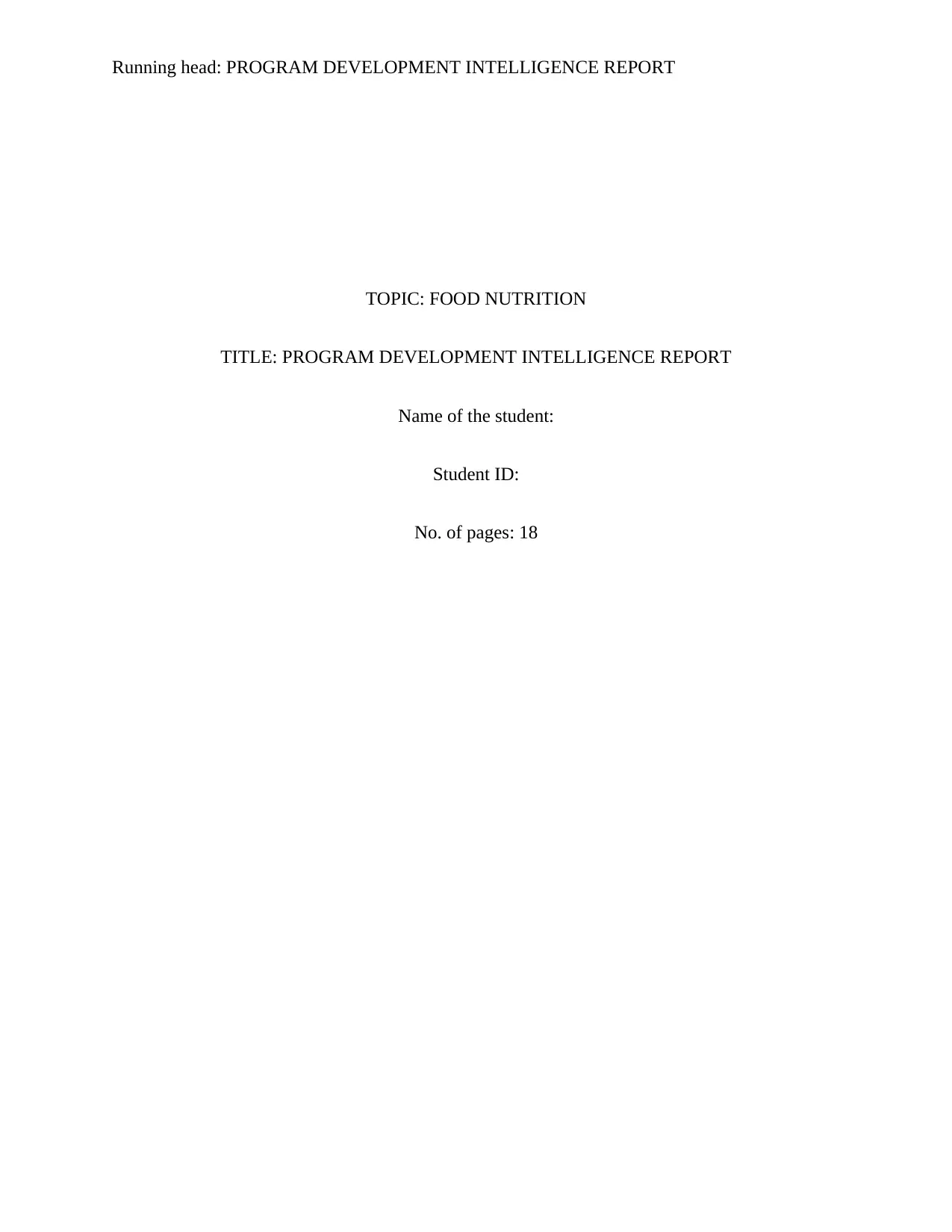
Running head: PROGRAM DEVELOPMENT INTELLIGENCE REPORT
TOPIC: FOOD NUTRITION
TITLE: PROGRAM DEVELOPMENT INTELLIGENCE REPORT
Name of the student:
Student ID:
No. of pages: 18
TOPIC: FOOD NUTRITION
TITLE: PROGRAM DEVELOPMENT INTELLIGENCE REPORT
Name of the student:
Student ID:
No. of pages: 18
Secure Best Marks with AI Grader
Need help grading? Try our AI Grader for instant feedback on your assignments.
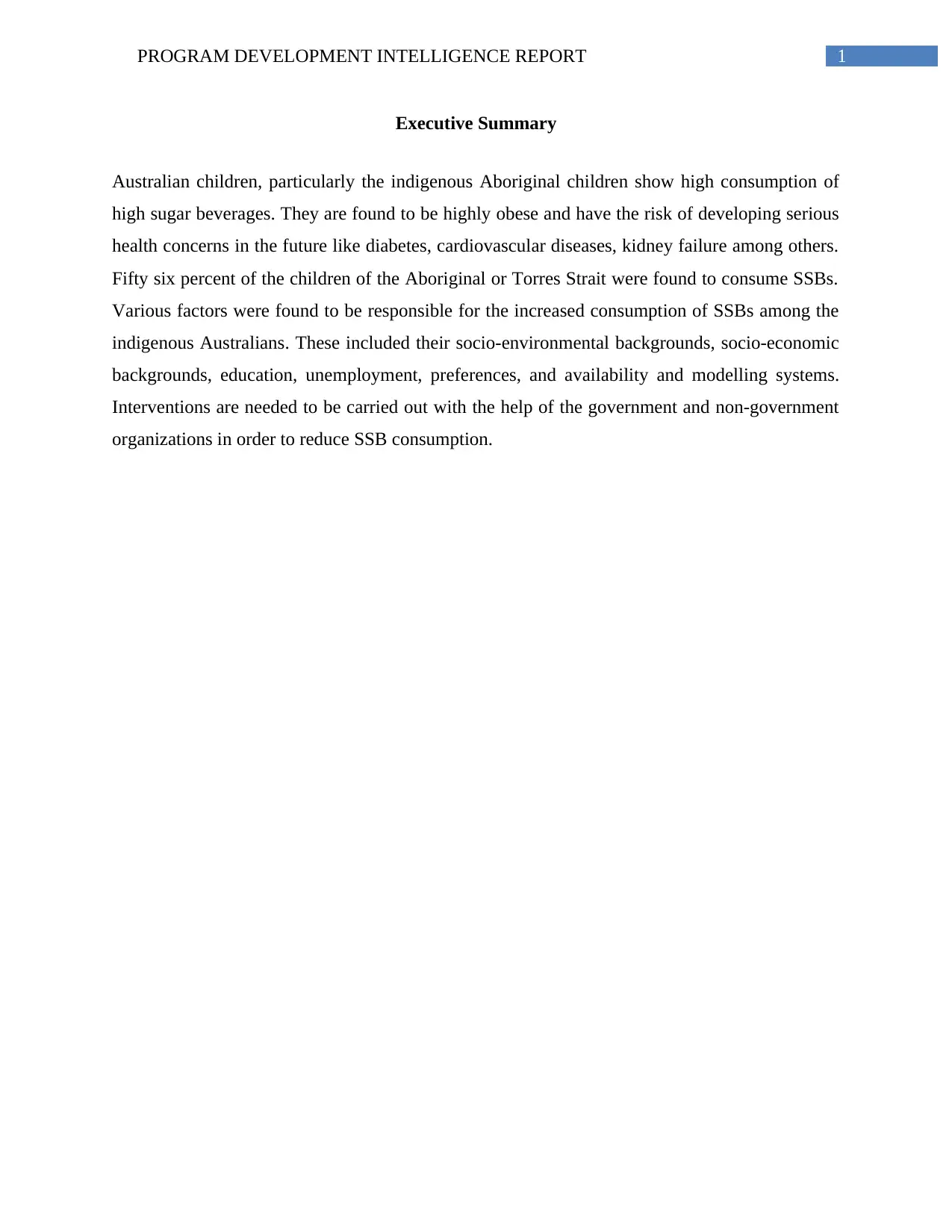
1PROGRAM DEVELOPMENT INTELLIGENCE REPORT
Executive Summary
Australian children, particularly the indigenous Aboriginal children show high consumption of
high sugar beverages. They are found to be highly obese and have the risk of developing serious
health concerns in the future like diabetes, cardiovascular diseases, kidney failure among others.
Fifty six percent of the children of the Aboriginal or Torres Strait were found to consume SSBs.
Various factors were found to be responsible for the increased consumption of SSBs among the
indigenous Australians. These included their socio-environmental backgrounds, socio-economic
backgrounds, education, unemployment, preferences, and availability and modelling systems.
Interventions are needed to be carried out with the help of the government and non-government
organizations in order to reduce SSB consumption.
Executive Summary
Australian children, particularly the indigenous Aboriginal children show high consumption of
high sugar beverages. They are found to be highly obese and have the risk of developing serious
health concerns in the future like diabetes, cardiovascular diseases, kidney failure among others.
Fifty six percent of the children of the Aboriginal or Torres Strait were found to consume SSBs.
Various factors were found to be responsible for the increased consumption of SSBs among the
indigenous Australians. These included their socio-environmental backgrounds, socio-economic
backgrounds, education, unemployment, preferences, and availability and modelling systems.
Interventions are needed to be carried out with the help of the government and non-government
organizations in order to reduce SSB consumption.
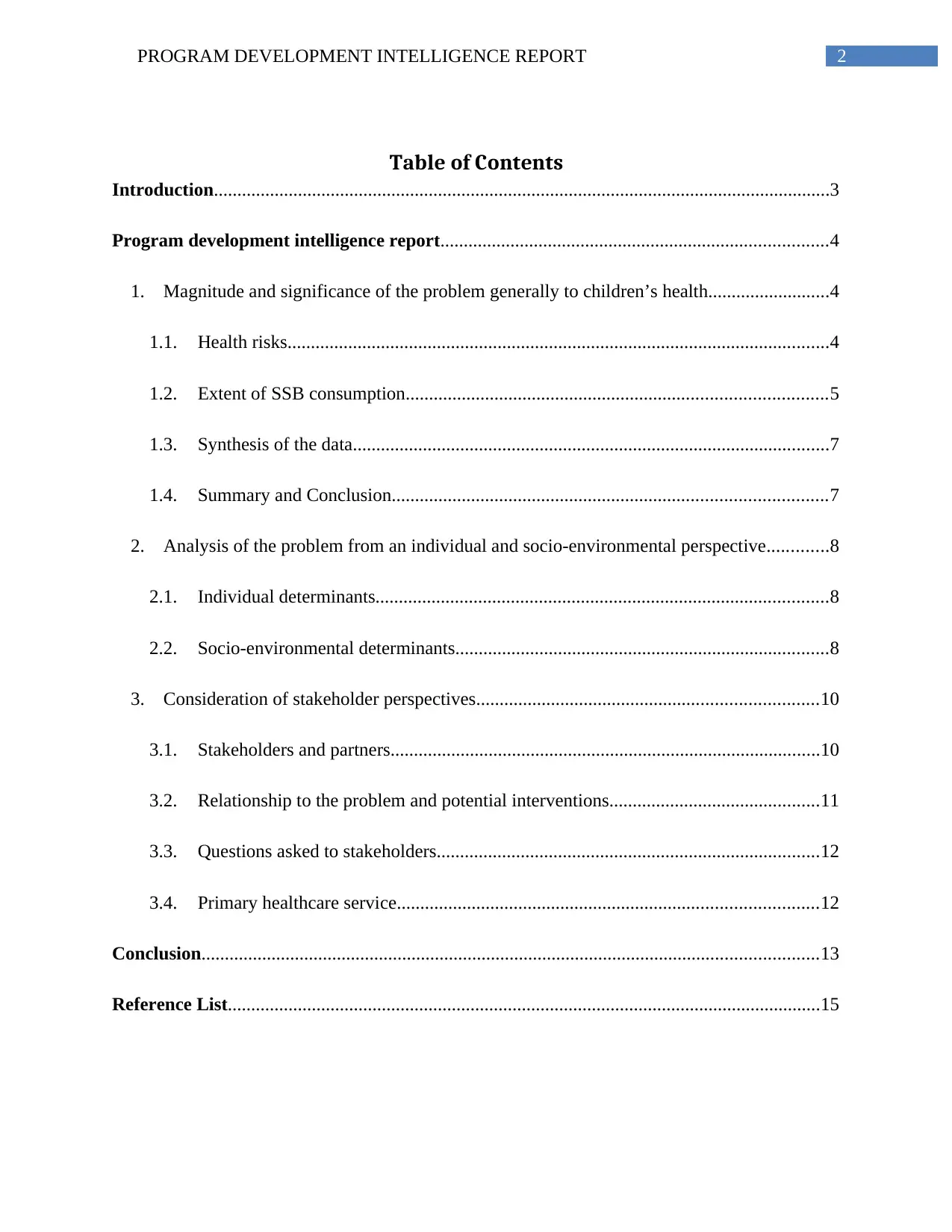
2PROGRAM DEVELOPMENT INTELLIGENCE REPORT
Table of Contents
Introduction....................................................................................................................................3
Program development intelligence report...................................................................................4
1. Magnitude and significance of the problem generally to children’s health..........................4
1.1. Health risks....................................................................................................................4
1.2. Extent of SSB consumption..........................................................................................5
1.3. Synthesis of the data......................................................................................................7
1.4. Summary and Conclusion.............................................................................................7
2. Analysis of the problem from an individual and socio-environmental perspective.............8
2.1. Individual determinants.................................................................................................8
2.2. Socio-environmental determinants................................................................................8
3. Consideration of stakeholder perspectives.........................................................................10
3.1. Stakeholders and partners............................................................................................10
3.2. Relationship to the problem and potential interventions.............................................11
3.3. Questions asked to stakeholders..................................................................................12
3.4. Primary healthcare service..........................................................................................12
Conclusion....................................................................................................................................13
Reference List...............................................................................................................................15
Table of Contents
Introduction....................................................................................................................................3
Program development intelligence report...................................................................................4
1. Magnitude and significance of the problem generally to children’s health..........................4
1.1. Health risks....................................................................................................................4
1.2. Extent of SSB consumption..........................................................................................5
1.3. Synthesis of the data......................................................................................................7
1.4. Summary and Conclusion.............................................................................................7
2. Analysis of the problem from an individual and socio-environmental perspective.............8
2.1. Individual determinants.................................................................................................8
2.2. Socio-environmental determinants................................................................................8
3. Consideration of stakeholder perspectives.........................................................................10
3.1. Stakeholders and partners............................................................................................10
3.2. Relationship to the problem and potential interventions.............................................11
3.3. Questions asked to stakeholders..................................................................................12
3.4. Primary healthcare service..........................................................................................12
Conclusion....................................................................................................................................13
Reference List...............................................................................................................................15
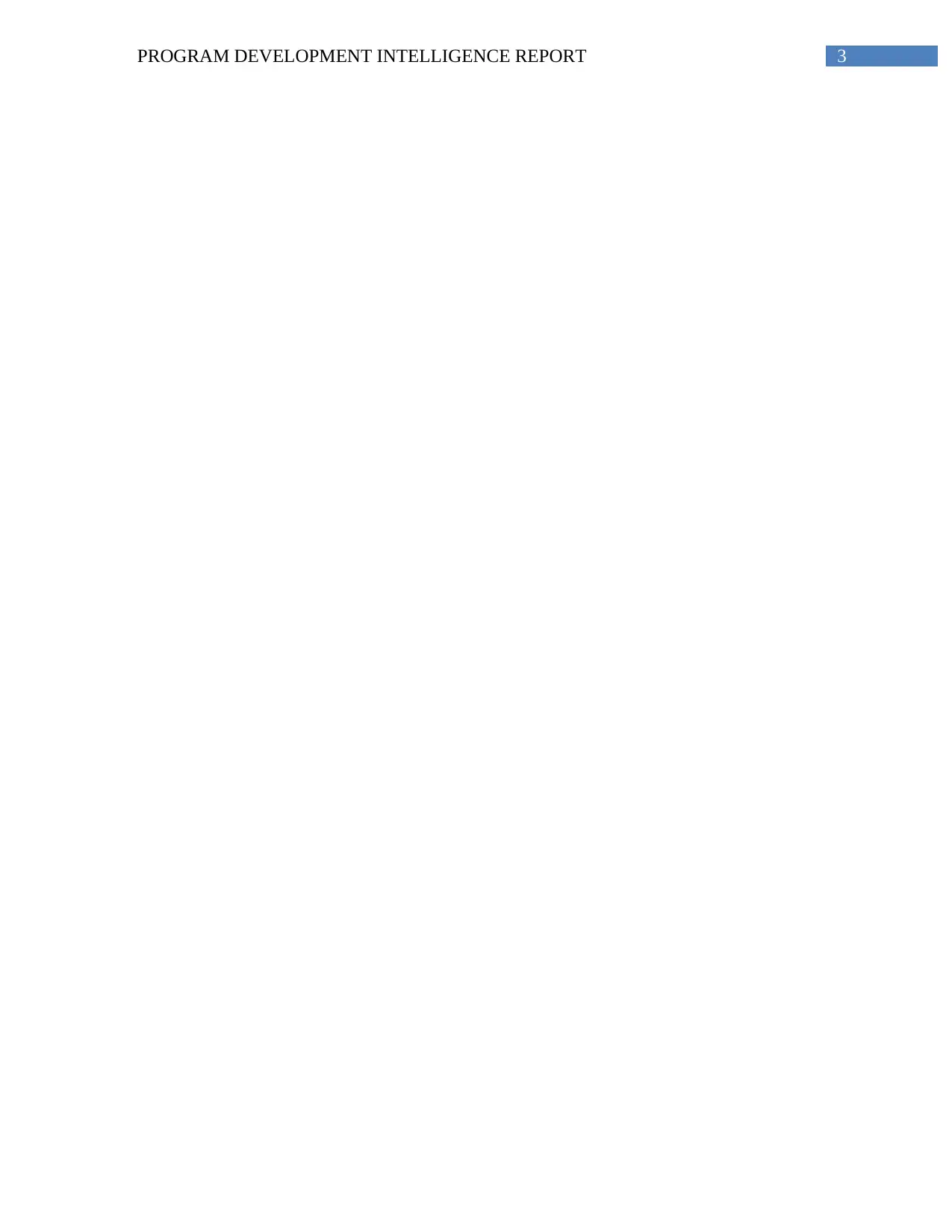
3PROGRAM DEVELOPMENT INTELLIGENCE REPORT
Secure Best Marks with AI Grader
Need help grading? Try our AI Grader for instant feedback on your assignments.

4PROGRAM DEVELOPMENT INTELLIGENCE REPORT
Introduction
Sugar sweetened beverages (SSBs) is linked to obesity in children. SSBs include
sweetened soft drinks, fruit juices with added sugars, sweetened tea, coffee, sodas, among others.
Consumption of SSBs has increased in children, adolescents and adults as well. These are
associated with dental caries, obesity and other medical conditions. SSB consumption is
associated with a high body mass index (BMI) and increased deposition of fat. Daily
consumption of SSBs can give rise to approximately 6.5 kg of weight gain in individuals in a
year. Australia is one of the top countries in the consumption of sugary drinks and majority of
the consumers are children (Vichealth.vic.gov.au, 2017).
This report focuses on understanding the ill effects of SSB consumption in the Australian
children particularly the indigenous Aboriginal and Torres Strait island children. Consumption of
SSBs results in obesity, diabetes, hypocalcaemia (increased levels of serum calcium), decreased
bone mineral density, dental caries, kidney stones, increase in the systolic and diastolic blood
pressure, among others. Type 2 diabetes is the prevalent form of diabetes among the children
consuming large amounts of SSBs (Rethinksugarydrink.org.au, 2017). In Australia, intake of
sweetened beverages were high among teenagers aged between 14-18 years, but on the average,
children aged between 2-18 years of age showed higher consumption than adults. About 50% of
the Aboriginal and Torres Strait Island children aged from 2 years drank high amounts of SSBs
compared to the non-indigenous people (Laws et al. 2014, p.779).
Figure 1: Graphical representation of BMI
Introduction
Sugar sweetened beverages (SSBs) is linked to obesity in children. SSBs include
sweetened soft drinks, fruit juices with added sugars, sweetened tea, coffee, sodas, among others.
Consumption of SSBs has increased in children, adolescents and adults as well. These are
associated with dental caries, obesity and other medical conditions. SSB consumption is
associated with a high body mass index (BMI) and increased deposition of fat. Daily
consumption of SSBs can give rise to approximately 6.5 kg of weight gain in individuals in a
year. Australia is one of the top countries in the consumption of sugary drinks and majority of
the consumers are children (Vichealth.vic.gov.au, 2017).
This report focuses on understanding the ill effects of SSB consumption in the Australian
children particularly the indigenous Aboriginal and Torres Strait island children. Consumption of
SSBs results in obesity, diabetes, hypocalcaemia (increased levels of serum calcium), decreased
bone mineral density, dental caries, kidney stones, increase in the systolic and diastolic blood
pressure, among others. Type 2 diabetes is the prevalent form of diabetes among the children
consuming large amounts of SSBs (Rethinksugarydrink.org.au, 2017). In Australia, intake of
sweetened beverages were high among teenagers aged between 14-18 years, but on the average,
children aged between 2-18 years of age showed higher consumption than adults. About 50% of
the Aboriginal and Torres Strait Island children aged from 2 years drank high amounts of SSBs
compared to the non-indigenous people (Laws et al. 2014, p.779).
Figure 1: Graphical representation of BMI

5PROGRAM DEVELOPMENT INTELLIGENCE REPORT
(Source: Pmc.gov.au, 2017)
This report at first focuses on the SSB consumption and the health risks associated with it.
This report specifically focuses on SSB consumption of the indigenous children of Australia. The
second part of the report deals with program planning and evaluation.
Program development intelligence report
1. Magnitude and significance of the problem generally to children’s health
1.1. Health risks
Increase in sugar availability has resulted in increased sugar intakes in the form of
various sweetened drinks. These SSBs include a variety of drinks like sodas, energy drinks,
sweetened fruit juices, soft drinks, sweetened tea, and coffee, among others (Scharf and DeBoer
2016, pp.273-293). Popularity of SSBs has increased among children, adolescents and adults.
Various health risks can arise due to consumption of SSBs. The most significant health risk
being obesity. Among 10 million Australians who are overweight or obese, 47% were found to
consume large amounts of SSBs. About 56% of the Aboriginal or Torres Strait Island children
aged about 2 years were found to consume SSBs (Abs.gov.au, 2017). Total intake of sugars,
starches, carbohydrates, fats, fibre and sodium were higher for the aboriginal children than the
non-indigenous children. Other health risks include, high body mass index, increased
hypocalcaemia, loss of bone mineral density, dental caries, kidney stones, and increase in
systolic and diastolic blood pressure. High BMI and higher deposition of fat was found
compared to the non-drinkers. Moreover, children also showed increase in the incidence of
dental caries. Hypocalcaemia or increase in the level of calcium in the serum was also evident.
Increase in SSB consumption among the Aboriginal and Torres Strait Islander children causes an
increased risk of developing heart diseases and type 2 diabetes (Brimblecombe et al. 2013,
pp.380-384).
Intake of large amounts of beverages or foods containing added sugars increases the total
energy consumption and subsequently results in dilution of the total nutrient intake. In recent
years, the occurrence of obesity among young children has increased particularly in the
(Source: Pmc.gov.au, 2017)
This report at first focuses on the SSB consumption and the health risks associated with it.
This report specifically focuses on SSB consumption of the indigenous children of Australia. The
second part of the report deals with program planning and evaluation.
Program development intelligence report
1. Magnitude and significance of the problem generally to children’s health
1.1. Health risks
Increase in sugar availability has resulted in increased sugar intakes in the form of
various sweetened drinks. These SSBs include a variety of drinks like sodas, energy drinks,
sweetened fruit juices, soft drinks, sweetened tea, and coffee, among others (Scharf and DeBoer
2016, pp.273-293). Popularity of SSBs has increased among children, adolescents and adults.
Various health risks can arise due to consumption of SSBs. The most significant health risk
being obesity. Among 10 million Australians who are overweight or obese, 47% were found to
consume large amounts of SSBs. About 56% of the Aboriginal or Torres Strait Island children
aged about 2 years were found to consume SSBs (Abs.gov.au, 2017). Total intake of sugars,
starches, carbohydrates, fats, fibre and sodium were higher for the aboriginal children than the
non-indigenous children. Other health risks include, high body mass index, increased
hypocalcaemia, loss of bone mineral density, dental caries, kidney stones, and increase in
systolic and diastolic blood pressure. High BMI and higher deposition of fat was found
compared to the non-drinkers. Moreover, children also showed increase in the incidence of
dental caries. Hypocalcaemia or increase in the level of calcium in the serum was also evident.
Increase in SSB consumption among the Aboriginal and Torres Strait Islander children causes an
increased risk of developing heart diseases and type 2 diabetes (Brimblecombe et al. 2013,
pp.380-384).
Intake of large amounts of beverages or foods containing added sugars increases the total
energy consumption and subsequently results in dilution of the total nutrient intake. In recent
years, the occurrence of obesity among young children has increased particularly in the

6PROGRAM DEVELOPMENT INTELLIGENCE REPORT
industrialized countries. Obesity in children gives rise to obese adults who can develop a number
of co-morbidities like cardiovascular diseases and diabetes (Sydney.edu.au, 2017). In type 2
diabetes, children develop insulin resistance and glucose levels increases in their blood stream
leading to various heart diseases, blindness as well as kidney failure. Diet plays a very important
role in development of atherosclerosis in children. Atherosclerosis and other heart diseases are
the primary cause of human death worldwide. The consumption of SSBs is the leading cause of
cardiovascular disease development in children. Soft drinks generally contain phosphoric acid,
which leads to the development of hypocalcaemia in children (Calvo and Tucker 2013, pp.29-
35). Hypocalcaemia results in increased serum calcium levels. Hypocalcaemia in children can
give rise to poor intelligence, papilledema, heart failure, intestinal malabsorption, among others.
Figure 2: Dental caries due to SSB consumption
(Source: Armfield et al. 2013, pp. 494-500)
1.2. Extent of SSB consumption
Increased consumption of SSBs particularly by children and adolescents can result in
high calorie intake. Sweetened beverages are responsible for the total intake of daily energy.
Higher consumption of SSBs is also associated with poor intake of fruits and higher intake of
unhealthy fast foods. Research has shown that increased intake of food is associated with those
industrialized countries. Obesity in children gives rise to obese adults who can develop a number
of co-morbidities like cardiovascular diseases and diabetes (Sydney.edu.au, 2017). In type 2
diabetes, children develop insulin resistance and glucose levels increases in their blood stream
leading to various heart diseases, blindness as well as kidney failure. Diet plays a very important
role in development of atherosclerosis in children. Atherosclerosis and other heart diseases are
the primary cause of human death worldwide. The consumption of SSBs is the leading cause of
cardiovascular disease development in children. Soft drinks generally contain phosphoric acid,
which leads to the development of hypocalcaemia in children (Calvo and Tucker 2013, pp.29-
35). Hypocalcaemia results in increased serum calcium levels. Hypocalcaemia in children can
give rise to poor intelligence, papilledema, heart failure, intestinal malabsorption, among others.
Figure 2: Dental caries due to SSB consumption
(Source: Armfield et al. 2013, pp. 494-500)
1.2. Extent of SSB consumption
Increased consumption of SSBs particularly by children and adolescents can result in
high calorie intake. Sweetened beverages are responsible for the total intake of daily energy.
Higher consumption of SSBs is also associated with poor intake of fruits and higher intake of
unhealthy fast foods. Research has shown that increased intake of food is associated with those
Paraphrase This Document
Need a fresh take? Get an instant paraphrase of this document with our AI Paraphraser
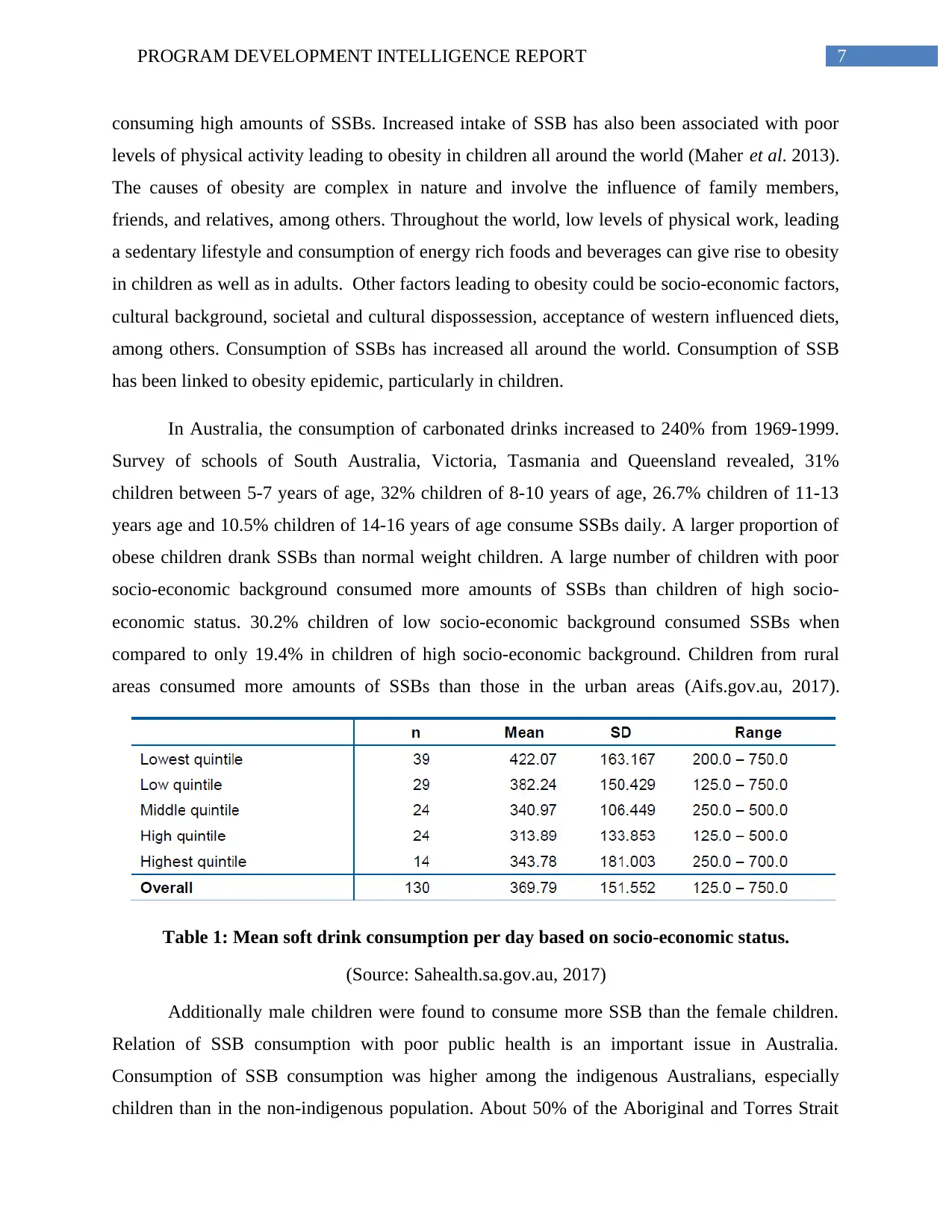
7PROGRAM DEVELOPMENT INTELLIGENCE REPORT
consuming high amounts of SSBs. Increased intake of SSB has also been associated with poor
levels of physical activity leading to obesity in children all around the world (Maher et al. 2013).
The causes of obesity are complex in nature and involve the influence of family members,
friends, and relatives, among others. Throughout the world, low levels of physical work, leading
a sedentary lifestyle and consumption of energy rich foods and beverages can give rise to obesity
in children as well as in adults. Other factors leading to obesity could be socio-economic factors,
cultural background, societal and cultural dispossession, acceptance of western influenced diets,
among others. Consumption of SSBs has increased all around the world. Consumption of SSB
has been linked to obesity epidemic, particularly in children.
In Australia, the consumption of carbonated drinks increased to 240% from 1969-1999.
Survey of schools of South Australia, Victoria, Tasmania and Queensland revealed, 31%
children between 5-7 years of age, 32% children of 8-10 years of age, 26.7% children of 11-13
years age and 10.5% children of 14-16 years of age consume SSBs daily. A larger proportion of
obese children drank SSBs than normal weight children. A large number of children with poor
socio-economic background consumed more amounts of SSBs than children of high socio-
economic status. 30.2% children of low socio-economic background consumed SSBs when
compared to only 19.4% in children of high socio-economic background. Children from rural
areas consumed more amounts of SSBs than those in the urban areas (Aifs.gov.au, 2017).
Table 1: Mean soft drink consumption per day based on socio-economic status.
(Source: Sahealth.sa.gov.au, 2017)
Additionally male children were found to consume more SSB than the female children.
Relation of SSB consumption with poor public health is an important issue in Australia.
Consumption of SSB consumption was higher among the indigenous Australians, especially
children than in the non-indigenous population. About 50% of the Aboriginal and Torres Strait
consuming high amounts of SSBs. Increased intake of SSB has also been associated with poor
levels of physical activity leading to obesity in children all around the world (Maher et al. 2013).
The causes of obesity are complex in nature and involve the influence of family members,
friends, and relatives, among others. Throughout the world, low levels of physical work, leading
a sedentary lifestyle and consumption of energy rich foods and beverages can give rise to obesity
in children as well as in adults. Other factors leading to obesity could be socio-economic factors,
cultural background, societal and cultural dispossession, acceptance of western influenced diets,
among others. Consumption of SSBs has increased all around the world. Consumption of SSB
has been linked to obesity epidemic, particularly in children.
In Australia, the consumption of carbonated drinks increased to 240% from 1969-1999.
Survey of schools of South Australia, Victoria, Tasmania and Queensland revealed, 31%
children between 5-7 years of age, 32% children of 8-10 years of age, 26.7% children of 11-13
years age and 10.5% children of 14-16 years of age consume SSBs daily. A larger proportion of
obese children drank SSBs than normal weight children. A large number of children with poor
socio-economic background consumed more amounts of SSBs than children of high socio-
economic status. 30.2% children of low socio-economic background consumed SSBs when
compared to only 19.4% in children of high socio-economic background. Children from rural
areas consumed more amounts of SSBs than those in the urban areas (Aifs.gov.au, 2017).
Table 1: Mean soft drink consumption per day based on socio-economic status.
(Source: Sahealth.sa.gov.au, 2017)
Additionally male children were found to consume more SSB than the female children.
Relation of SSB consumption with poor public health is an important issue in Australia.
Consumption of SSB consumption was higher among the indigenous Australians, especially
children than in the non-indigenous population. About 50% of the Aboriginal and Torres Strait
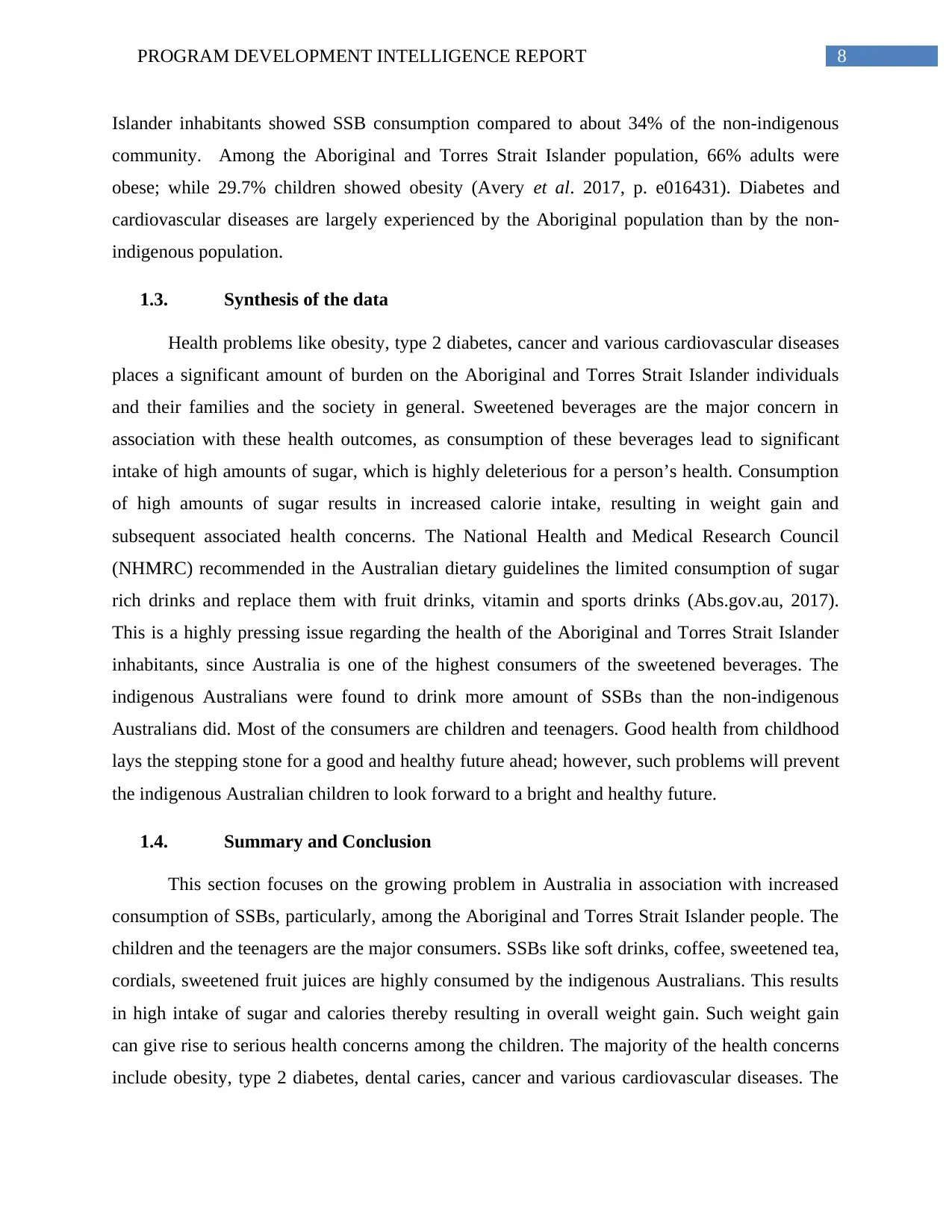
8PROGRAM DEVELOPMENT INTELLIGENCE REPORT
Islander inhabitants showed SSB consumption compared to about 34% of the non-indigenous
community. Among the Aboriginal and Torres Strait Islander population, 66% adults were
obese; while 29.7% children showed obesity (Avery et al. 2017, p. e016431). Diabetes and
cardiovascular diseases are largely experienced by the Aboriginal population than by the non-
indigenous population.
1.3. Synthesis of the data
Health problems like obesity, type 2 diabetes, cancer and various cardiovascular diseases
places a significant amount of burden on the Aboriginal and Torres Strait Islander individuals
and their families and the society in general. Sweetened beverages are the major concern in
association with these health outcomes, as consumption of these beverages lead to significant
intake of high amounts of sugar, which is highly deleterious for a person’s health. Consumption
of high amounts of sugar results in increased calorie intake, resulting in weight gain and
subsequent associated health concerns. The National Health and Medical Research Council
(NHMRC) recommended in the Australian dietary guidelines the limited consumption of sugar
rich drinks and replace them with fruit drinks, vitamin and sports drinks (Abs.gov.au, 2017).
This is a highly pressing issue regarding the health of the Aboriginal and Torres Strait Islander
inhabitants, since Australia is one of the highest consumers of the sweetened beverages. The
indigenous Australians were found to drink more amount of SSBs than the non-indigenous
Australians did. Most of the consumers are children and teenagers. Good health from childhood
lays the stepping stone for a good and healthy future ahead; however, such problems will prevent
the indigenous Australian children to look forward to a bright and healthy future.
1.4. Summary and Conclusion
This section focuses on the growing problem in Australia in association with increased
consumption of SSBs, particularly, among the Aboriginal and Torres Strait Islander people. The
children and the teenagers are the major consumers. SSBs like soft drinks, coffee, sweetened tea,
cordials, sweetened fruit juices are highly consumed by the indigenous Australians. This results
in high intake of sugar and calories thereby resulting in overall weight gain. Such weight gain
can give rise to serious health concerns among the children. The majority of the health concerns
include obesity, type 2 diabetes, dental caries, cancer and various cardiovascular diseases. The
Islander inhabitants showed SSB consumption compared to about 34% of the non-indigenous
community. Among the Aboriginal and Torres Strait Islander population, 66% adults were
obese; while 29.7% children showed obesity (Avery et al. 2017, p. e016431). Diabetes and
cardiovascular diseases are largely experienced by the Aboriginal population than by the non-
indigenous population.
1.3. Synthesis of the data
Health problems like obesity, type 2 diabetes, cancer and various cardiovascular diseases
places a significant amount of burden on the Aboriginal and Torres Strait Islander individuals
and their families and the society in general. Sweetened beverages are the major concern in
association with these health outcomes, as consumption of these beverages lead to significant
intake of high amounts of sugar, which is highly deleterious for a person’s health. Consumption
of high amounts of sugar results in increased calorie intake, resulting in weight gain and
subsequent associated health concerns. The National Health and Medical Research Council
(NHMRC) recommended in the Australian dietary guidelines the limited consumption of sugar
rich drinks and replace them with fruit drinks, vitamin and sports drinks (Abs.gov.au, 2017).
This is a highly pressing issue regarding the health of the Aboriginal and Torres Strait Islander
inhabitants, since Australia is one of the highest consumers of the sweetened beverages. The
indigenous Australians were found to drink more amount of SSBs than the non-indigenous
Australians did. Most of the consumers are children and teenagers. Good health from childhood
lays the stepping stone for a good and healthy future ahead; however, such problems will prevent
the indigenous Australian children to look forward to a bright and healthy future.
1.4. Summary and Conclusion
This section focuses on the growing problem in Australia in association with increased
consumption of SSBs, particularly, among the Aboriginal and Torres Strait Islander people. The
children and the teenagers are the major consumers. SSBs like soft drinks, coffee, sweetened tea,
cordials, sweetened fruit juices are highly consumed by the indigenous Australians. This results
in high intake of sugar and calories thereby resulting in overall weight gain. Such weight gain
can give rise to serious health concerns among the children. The majority of the health concerns
include obesity, type 2 diabetes, dental caries, cancer and various cardiovascular diseases. The
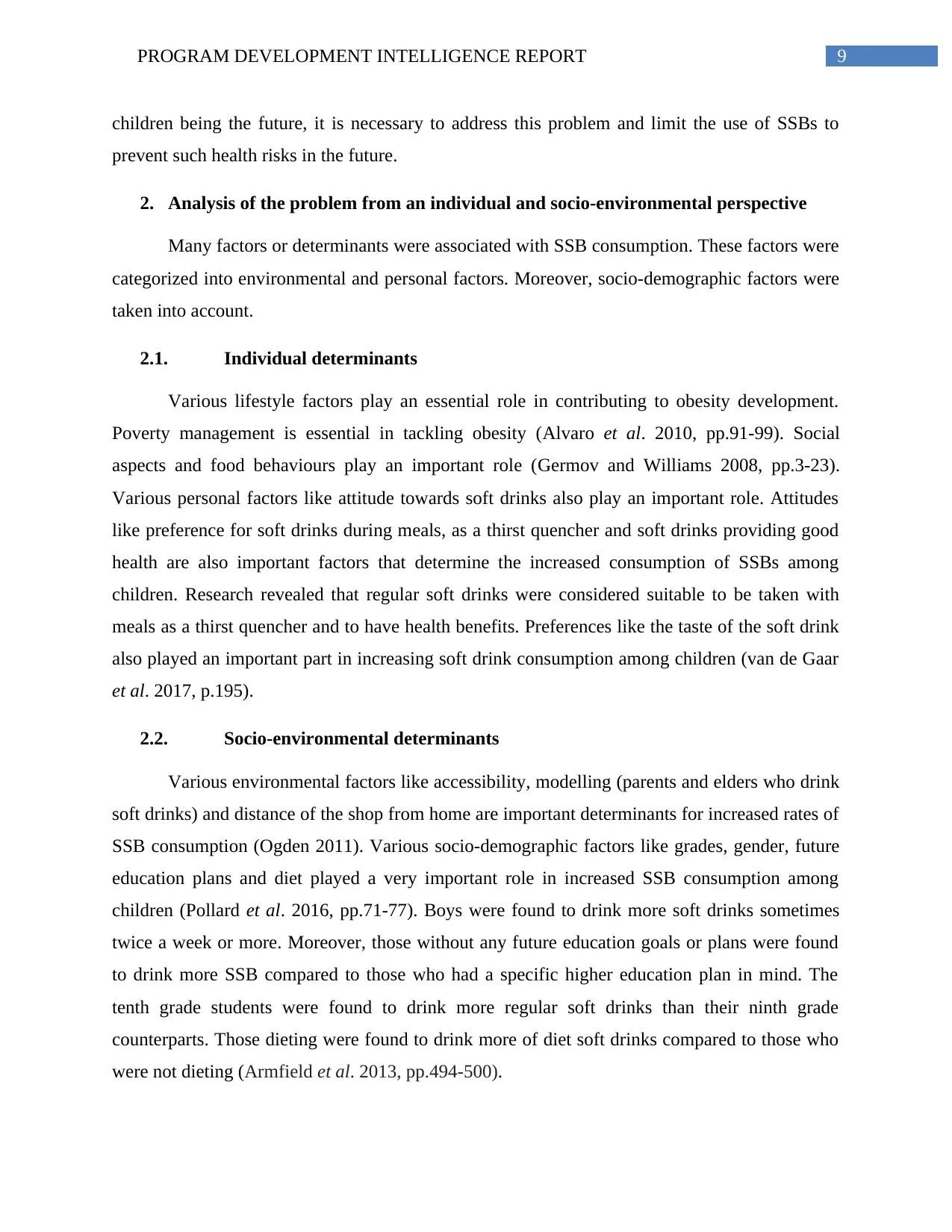
9PROGRAM DEVELOPMENT INTELLIGENCE REPORT
children being the future, it is necessary to address this problem and limit the use of SSBs to
prevent such health risks in the future.
2. Analysis of the problem from an individual and socio-environmental perspective
Many factors or determinants were associated with SSB consumption. These factors were
categorized into environmental and personal factors. Moreover, socio-demographic factors were
taken into account.
2.1. Individual determinants
Various lifestyle factors play an essential role in contributing to obesity development.
Poverty management is essential in tackling obesity (Alvaro et al. 2010, pp.91-99). Social
aspects and food behaviours play an important role (Germov and Williams 2008, pp.3-23).
Various personal factors like attitude towards soft drinks also play an important role. Attitudes
like preference for soft drinks during meals, as a thirst quencher and soft drinks providing good
health are also important factors that determine the increased consumption of SSBs among
children. Research revealed that regular soft drinks were considered suitable to be taken with
meals as a thirst quencher and to have health benefits. Preferences like the taste of the soft drink
also played an important part in increasing soft drink consumption among children (van de Gaar
et al. 2017, p.195).
2.2. Socio-environmental determinants
Various environmental factors like accessibility, modelling (parents and elders who drink
soft drinks) and distance of the shop from home are important determinants for increased rates of
SSB consumption (Ogden 2011). Various socio-demographic factors like grades, gender, future
education plans and diet played a very important role in increased SSB consumption among
children (Pollard et al. 2016, pp.71-77). Boys were found to drink more soft drinks sometimes
twice a week or more. Moreover, those without any future education goals or plans were found
to drink more SSB compared to those who had a specific higher education plan in mind. The
tenth grade students were found to drink more regular soft drinks than their ninth grade
counterparts. Those dieting were found to drink more of diet soft drinks compared to those who
were not dieting (Armfield et al. 2013, pp.494-500).
children being the future, it is necessary to address this problem and limit the use of SSBs to
prevent such health risks in the future.
2. Analysis of the problem from an individual and socio-environmental perspective
Many factors or determinants were associated with SSB consumption. These factors were
categorized into environmental and personal factors. Moreover, socio-demographic factors were
taken into account.
2.1. Individual determinants
Various lifestyle factors play an essential role in contributing to obesity development.
Poverty management is essential in tackling obesity (Alvaro et al. 2010, pp.91-99). Social
aspects and food behaviours play an important role (Germov and Williams 2008, pp.3-23).
Various personal factors like attitude towards soft drinks also play an important role. Attitudes
like preference for soft drinks during meals, as a thirst quencher and soft drinks providing good
health are also important factors that determine the increased consumption of SSBs among
children. Research revealed that regular soft drinks were considered suitable to be taken with
meals as a thirst quencher and to have health benefits. Preferences like the taste of the soft drink
also played an important part in increasing soft drink consumption among children (van de Gaar
et al. 2017, p.195).
2.2. Socio-environmental determinants
Various environmental factors like accessibility, modelling (parents and elders who drink
soft drinks) and distance of the shop from home are important determinants for increased rates of
SSB consumption (Ogden 2011). Various socio-demographic factors like grades, gender, future
education plans and diet played a very important role in increased SSB consumption among
children (Pollard et al. 2016, pp.71-77). Boys were found to drink more soft drinks sometimes
twice a week or more. Moreover, those without any future education goals or plans were found
to drink more SSB compared to those who had a specific higher education plan in mind. The
tenth grade students were found to drink more regular soft drinks than their ninth grade
counterparts. Those dieting were found to drink more of diet soft drinks compared to those who
were not dieting (Armfield et al. 2013, pp.494-500).
Secure Best Marks with AI Grader
Need help grading? Try our AI Grader for instant feedback on your assignments.
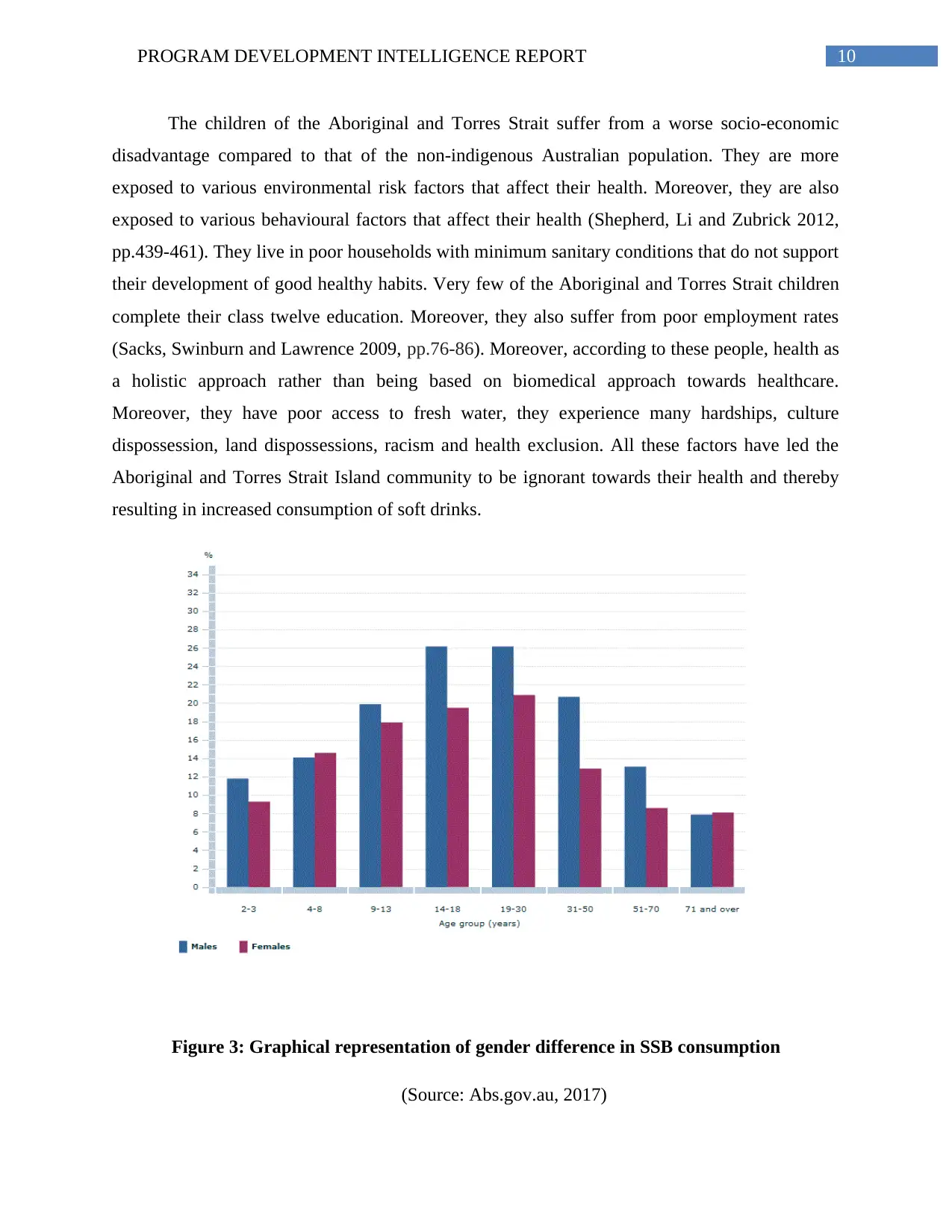
10PROGRAM DEVELOPMENT INTELLIGENCE REPORT
The children of the Aboriginal and Torres Strait suffer from a worse socio-economic
disadvantage compared to that of the non-indigenous Australian population. They are more
exposed to various environmental risk factors that affect their health. Moreover, they are also
exposed to various behavioural factors that affect their health (Shepherd, Li and Zubrick 2012,
pp.439-461). They live in poor households with minimum sanitary conditions that do not support
their development of good healthy habits. Very few of the Aboriginal and Torres Strait children
complete their class twelve education. Moreover, they also suffer from poor employment rates
(Sacks, Swinburn and Lawrence 2009, pp.76-86). Moreover, according to these people, health as
a holistic approach rather than being based on biomedical approach towards healthcare.
Moreover, they have poor access to fresh water, they experience many hardships, culture
dispossession, land dispossessions, racism and health exclusion. All these factors have led the
Aboriginal and Torres Strait Island community to be ignorant towards their health and thereby
resulting in increased consumption of soft drinks.
Figure 3: Graphical representation of gender difference in SSB consumption
(Source: Abs.gov.au, 2017)
The children of the Aboriginal and Torres Strait suffer from a worse socio-economic
disadvantage compared to that of the non-indigenous Australian population. They are more
exposed to various environmental risk factors that affect their health. Moreover, they are also
exposed to various behavioural factors that affect their health (Shepherd, Li and Zubrick 2012,
pp.439-461). They live in poor households with minimum sanitary conditions that do not support
their development of good healthy habits. Very few of the Aboriginal and Torres Strait children
complete their class twelve education. Moreover, they also suffer from poor employment rates
(Sacks, Swinburn and Lawrence 2009, pp.76-86). Moreover, according to these people, health as
a holistic approach rather than being based on biomedical approach towards healthcare.
Moreover, they have poor access to fresh water, they experience many hardships, culture
dispossession, land dispossessions, racism and health exclusion. All these factors have led the
Aboriginal and Torres Strait Island community to be ignorant towards their health and thereby
resulting in increased consumption of soft drinks.
Figure 3: Graphical representation of gender difference in SSB consumption
(Source: Abs.gov.au, 2017)
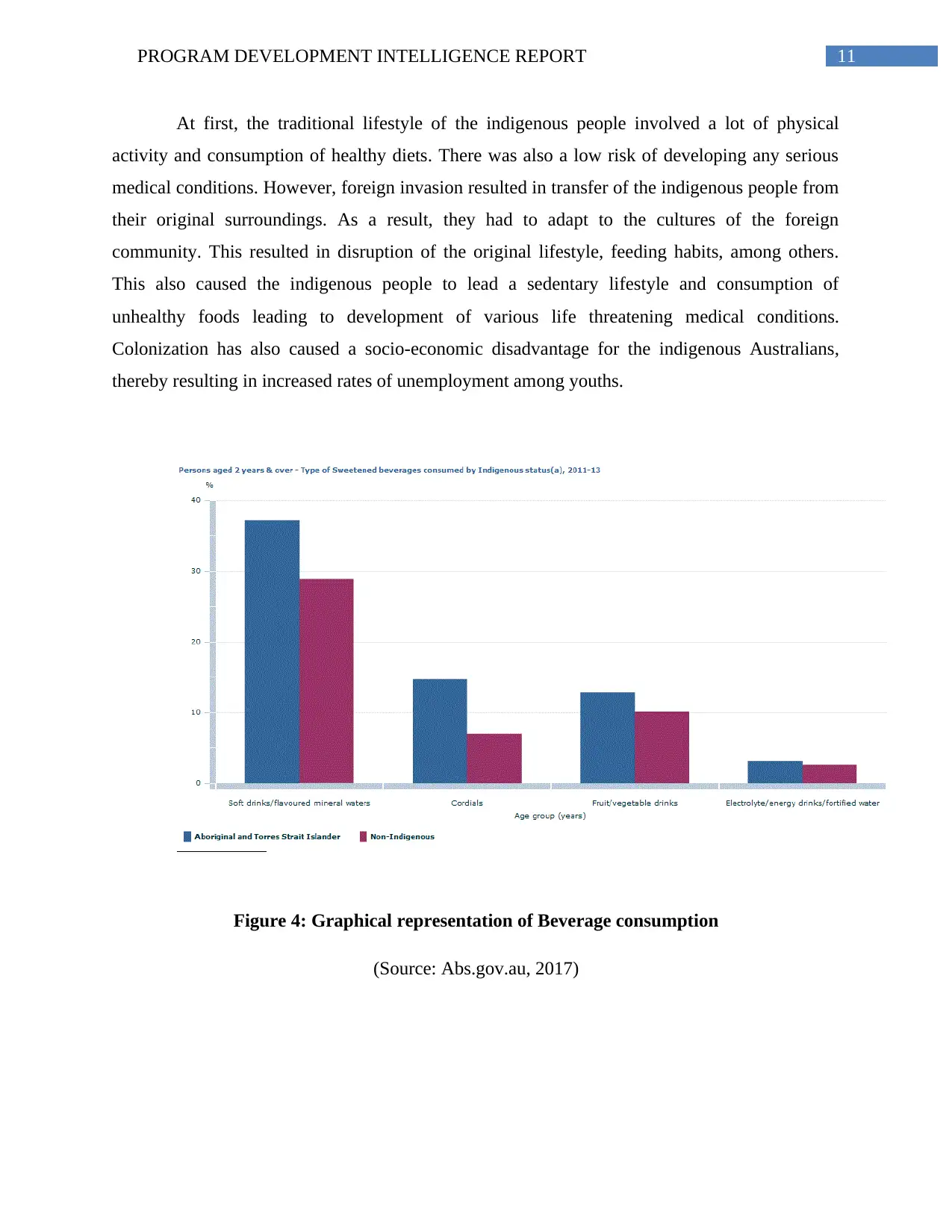
11PROGRAM DEVELOPMENT INTELLIGENCE REPORT
At first, the traditional lifestyle of the indigenous people involved a lot of physical
activity and consumption of healthy diets. There was also a low risk of developing any serious
medical conditions. However, foreign invasion resulted in transfer of the indigenous people from
their original surroundings. As a result, they had to adapt to the cultures of the foreign
community. This resulted in disruption of the original lifestyle, feeding habits, among others.
This also caused the indigenous people to lead a sedentary lifestyle and consumption of
unhealthy foods leading to development of various life threatening medical conditions.
Colonization has also caused a socio-economic disadvantage for the indigenous Australians,
thereby resulting in increased rates of unemployment among youths.
Figure 4: Graphical representation of Beverage consumption
(Source: Abs.gov.au, 2017)
At first, the traditional lifestyle of the indigenous people involved a lot of physical
activity and consumption of healthy diets. There was also a low risk of developing any serious
medical conditions. However, foreign invasion resulted in transfer of the indigenous people from
their original surroundings. As a result, they had to adapt to the cultures of the foreign
community. This resulted in disruption of the original lifestyle, feeding habits, among others.
This also caused the indigenous people to lead a sedentary lifestyle and consumption of
unhealthy foods leading to development of various life threatening medical conditions.
Colonization has also caused a socio-economic disadvantage for the indigenous Australians,
thereby resulting in increased rates of unemployment among youths.
Figure 4: Graphical representation of Beverage consumption
(Source: Abs.gov.au, 2017)
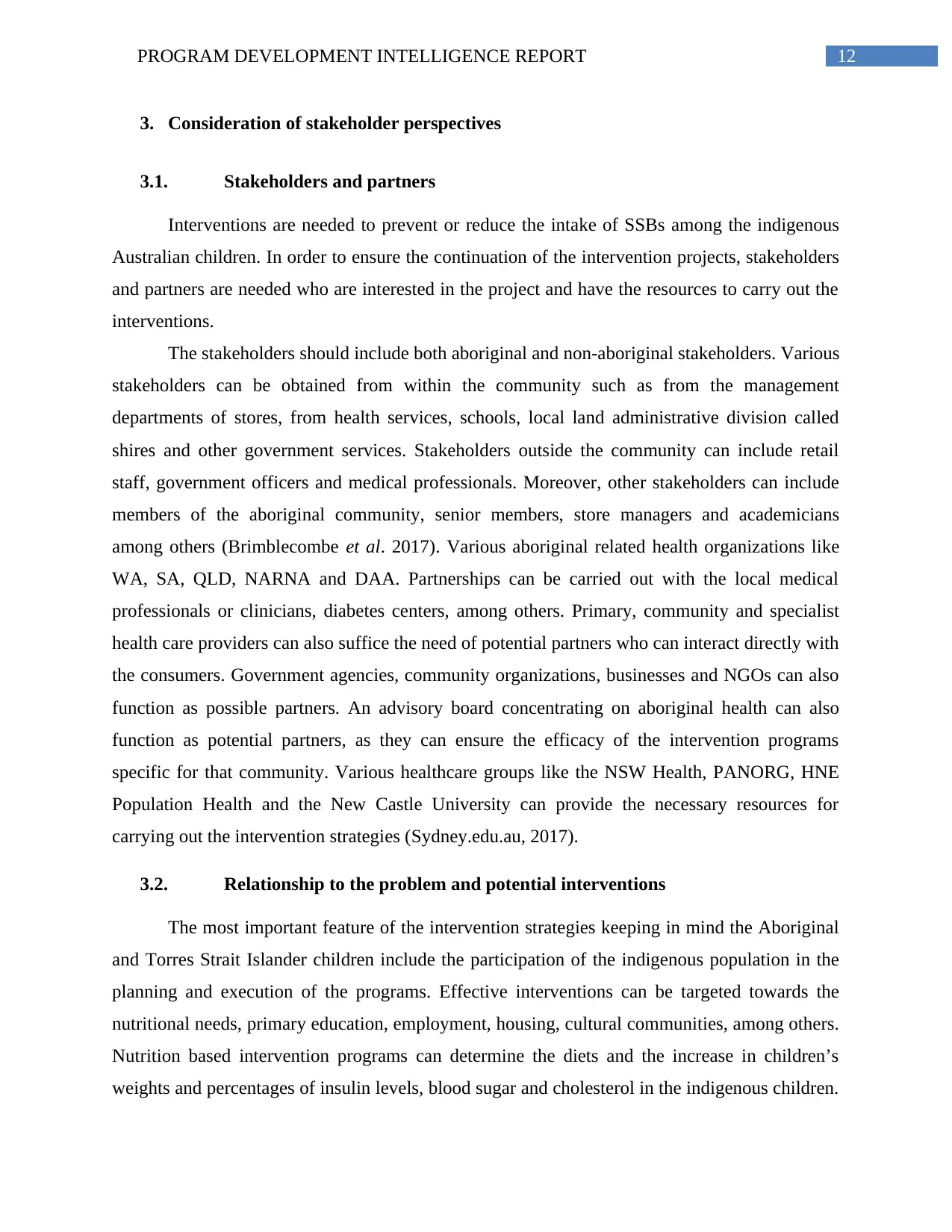
12PROGRAM DEVELOPMENT INTELLIGENCE REPORT
3. Consideration of stakeholder perspectives
3.1. Stakeholders and partners
Interventions are needed to prevent or reduce the intake of SSBs among the indigenous
Australian children. In order to ensure the continuation of the intervention projects, stakeholders
and partners are needed who are interested in the project and have the resources to carry out the
interventions.
The stakeholders should include both aboriginal and non-aboriginal stakeholders. Various
stakeholders can be obtained from within the community such as from the management
departments of stores, from health services, schools, local land administrative division called
shires and other government services. Stakeholders outside the community can include retail
staff, government officers and medical professionals. Moreover, other stakeholders can include
members of the aboriginal community, senior members, store managers and academicians
among others (Brimblecombe et al. 2017). Various aboriginal related health organizations like
WA, SA, QLD, NARNA and DAA. Partnerships can be carried out with the local medical
professionals or clinicians, diabetes centers, among others. Primary, community and specialist
health care providers can also suffice the need of potential partners who can interact directly with
the consumers. Government agencies, community organizations, businesses and NGOs can also
function as possible partners. An advisory board concentrating on aboriginal health can also
function as potential partners, as they can ensure the efficacy of the intervention programs
specific for that community. Various healthcare groups like the NSW Health, PANORG, HNE
Population Health and the New Castle University can provide the necessary resources for
carrying out the intervention strategies (Sydney.edu.au, 2017).
3.2. Relationship to the problem and potential interventions
The most important feature of the intervention strategies keeping in mind the Aboriginal
and Torres Strait Islander children include the participation of the indigenous population in the
planning and execution of the programs. Effective interventions can be targeted towards the
nutritional needs, primary education, employment, housing, cultural communities, among others.
Nutrition based intervention programs can determine the diets and the increase in children’s
weights and percentages of insulin levels, blood sugar and cholesterol in the indigenous children.
3. Consideration of stakeholder perspectives
3.1. Stakeholders and partners
Interventions are needed to prevent or reduce the intake of SSBs among the indigenous
Australian children. In order to ensure the continuation of the intervention projects, stakeholders
and partners are needed who are interested in the project and have the resources to carry out the
interventions.
The stakeholders should include both aboriginal and non-aboriginal stakeholders. Various
stakeholders can be obtained from within the community such as from the management
departments of stores, from health services, schools, local land administrative division called
shires and other government services. Stakeholders outside the community can include retail
staff, government officers and medical professionals. Moreover, other stakeholders can include
members of the aboriginal community, senior members, store managers and academicians
among others (Brimblecombe et al. 2017). Various aboriginal related health organizations like
WA, SA, QLD, NARNA and DAA. Partnerships can be carried out with the local medical
professionals or clinicians, diabetes centers, among others. Primary, community and specialist
health care providers can also suffice the need of potential partners who can interact directly with
the consumers. Government agencies, community organizations, businesses and NGOs can also
function as possible partners. An advisory board concentrating on aboriginal health can also
function as potential partners, as they can ensure the efficacy of the intervention programs
specific for that community. Various healthcare groups like the NSW Health, PANORG, HNE
Population Health and the New Castle University can provide the necessary resources for
carrying out the intervention strategies (Sydney.edu.au, 2017).
3.2. Relationship to the problem and potential interventions
The most important feature of the intervention strategies keeping in mind the Aboriginal
and Torres Strait Islander children include the participation of the indigenous population in the
planning and execution of the programs. Effective interventions can be targeted towards the
nutritional needs, primary education, employment, housing, cultural communities, among others.
Nutrition based intervention programs can determine the diets and the increase in children’s
weights and percentages of insulin levels, blood sugar and cholesterol in the indigenous children.
Paraphrase This Document
Need a fresh take? Get an instant paraphrase of this document with our AI Paraphraser
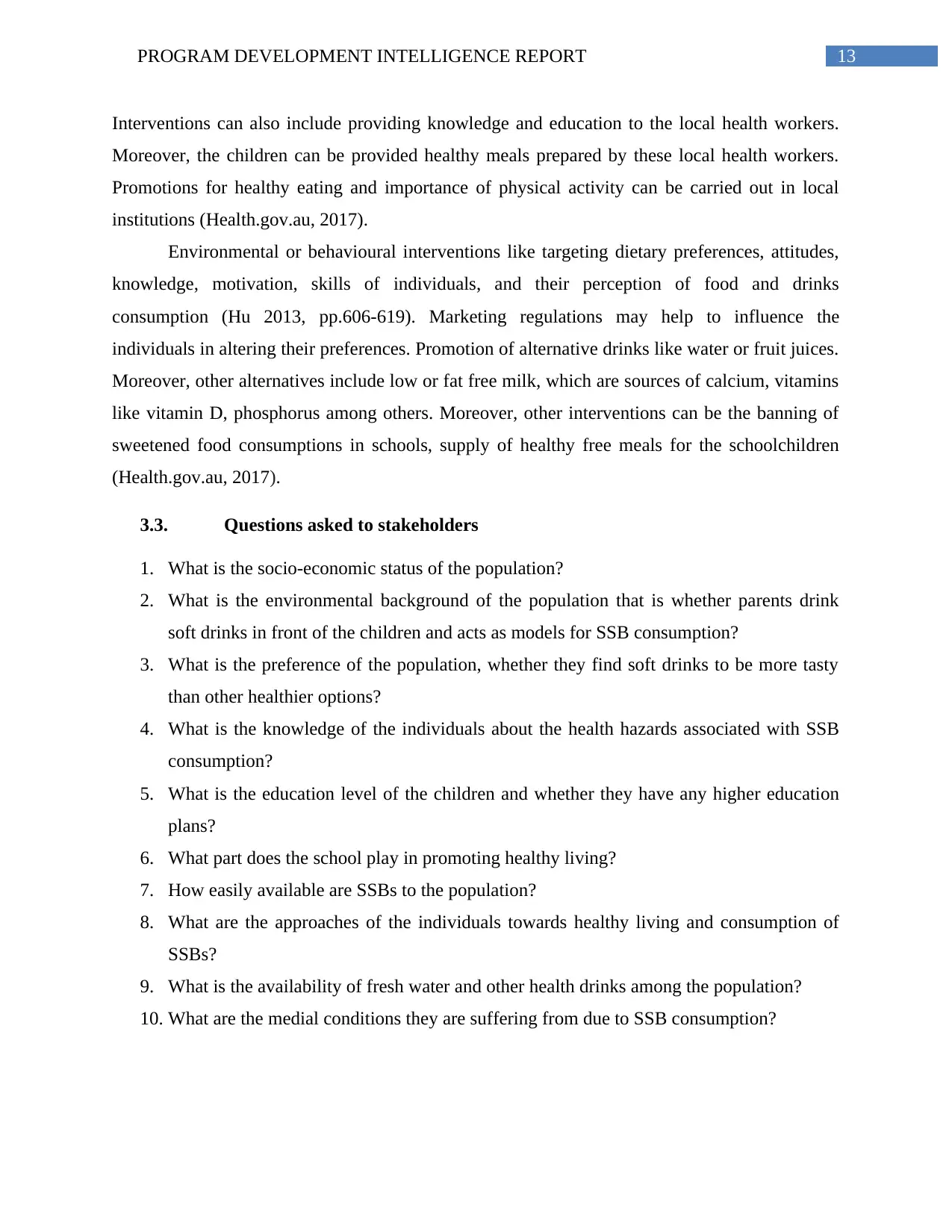
13PROGRAM DEVELOPMENT INTELLIGENCE REPORT
Interventions can also include providing knowledge and education to the local health workers.
Moreover, the children can be provided healthy meals prepared by these local health workers.
Promotions for healthy eating and importance of physical activity can be carried out in local
institutions (Health.gov.au, 2017).
Environmental or behavioural interventions like targeting dietary preferences, attitudes,
knowledge, motivation, skills of individuals, and their perception of food and drinks
consumption (Hu 2013, pp.606-619). Marketing regulations may help to influence the
individuals in altering their preferences. Promotion of alternative drinks like water or fruit juices.
Moreover, other alternatives include low or fat free milk, which are sources of calcium, vitamins
like vitamin D, phosphorus among others. Moreover, other interventions can be the banning of
sweetened food consumptions in schools, supply of healthy free meals for the schoolchildren
(Health.gov.au, 2017).
3.3. Questions asked to stakeholders
1. What is the socio-economic status of the population?
2. What is the environmental background of the population that is whether parents drink
soft drinks in front of the children and acts as models for SSB consumption?
3. What is the preference of the population, whether they find soft drinks to be more tasty
than other healthier options?
4. What is the knowledge of the individuals about the health hazards associated with SSB
consumption?
5. What is the education level of the children and whether they have any higher education
plans?
6. What part does the school play in promoting healthy living?
7. How easily available are SSBs to the population?
8. What are the approaches of the individuals towards healthy living and consumption of
SSBs?
9. What is the availability of fresh water and other health drinks among the population?
10. What are the medial conditions they are suffering from due to SSB consumption?
Interventions can also include providing knowledge and education to the local health workers.
Moreover, the children can be provided healthy meals prepared by these local health workers.
Promotions for healthy eating and importance of physical activity can be carried out in local
institutions (Health.gov.au, 2017).
Environmental or behavioural interventions like targeting dietary preferences, attitudes,
knowledge, motivation, skills of individuals, and their perception of food and drinks
consumption (Hu 2013, pp.606-619). Marketing regulations may help to influence the
individuals in altering their preferences. Promotion of alternative drinks like water or fruit juices.
Moreover, other alternatives include low or fat free milk, which are sources of calcium, vitamins
like vitamin D, phosphorus among others. Moreover, other interventions can be the banning of
sweetened food consumptions in schools, supply of healthy free meals for the schoolchildren
(Health.gov.au, 2017).
3.3. Questions asked to stakeholders
1. What is the socio-economic status of the population?
2. What is the environmental background of the population that is whether parents drink
soft drinks in front of the children and acts as models for SSB consumption?
3. What is the preference of the population, whether they find soft drinks to be more tasty
than other healthier options?
4. What is the knowledge of the individuals about the health hazards associated with SSB
consumption?
5. What is the education level of the children and whether they have any higher education
plans?
6. What part does the school play in promoting healthy living?
7. How easily available are SSBs to the population?
8. What are the approaches of the individuals towards healthy living and consumption of
SSBs?
9. What is the availability of fresh water and other health drinks among the population?
10. What are the medial conditions they are suffering from due to SSB consumption?

14PROGRAM DEVELOPMENT INTELLIGENCE REPORT
3.4. Primary healthcare service
Primary healthcare methods or principles form the basis of program development and
promotion of health among the Aboriginal and Torres Strait Islander people. Questionnaires can
be developed to determine the eating habits, activity levels, behaviour, knowledge and socio-
economic condition of the population. These questionnaires are used to obtain the information
from the children, parents, teachers, canteen supervisors and principals about the surrounding
environment and diet preference of the population. Questionnaires can also cover other domains
of interest like individual behaviour or attitude, knowledge and skills of the teacher, and the
emotional well-being of the children.
Moreover, the ANGELO tool can be used to determine the physical, socio-economical
and socio-cultural environments associated with the development of obesity (Belon et al. 2016,
pp.e92-e100). Social and emotional well being screening tools that can be used are Kessler 5,
Kessler 6, Kessler 10, Patient Health Questionnaire 2, Patient Health Questionnaire 9 and
Edinburgh Postnatal Depression Screen (Jorm et al. 2012, p.118). Mental health of an individual
controls their behaviour and day-to-day activities.
Depending on the informations obtained after the survey, various healthcare practices can
be carried out. These include promotion of healthy food choices, increased physical activity, and
supply of resources, tools and information for making healthy choices.
Conclusion
Consumption of sugar rich foods and beverages are a serious health concern that has
affected many countries around the world, particularly, those countries that are highly
industrialized. SSBs include various soft drinks, health drinks, sodas, sweetened tea, sweetened
coffee, sweetened canned fruit juices, among others. These sweetened beverages contain high
amounts of sugar, which affects the general health and lifestyle of individuals around the world.
Consumption of these sweetened beverages has increased in children all around the world. This
results in the development of obesity among children. Obesity in childhood can give rise to
serious health concerns like cardiovascular diseases, kidney failure and diabetes in adults.
Australia is one of the top countries consuming large amounts of sweetened beverages. The
3.4. Primary healthcare service
Primary healthcare methods or principles form the basis of program development and
promotion of health among the Aboriginal and Torres Strait Islander people. Questionnaires can
be developed to determine the eating habits, activity levels, behaviour, knowledge and socio-
economic condition of the population. These questionnaires are used to obtain the information
from the children, parents, teachers, canteen supervisors and principals about the surrounding
environment and diet preference of the population. Questionnaires can also cover other domains
of interest like individual behaviour or attitude, knowledge and skills of the teacher, and the
emotional well-being of the children.
Moreover, the ANGELO tool can be used to determine the physical, socio-economical
and socio-cultural environments associated with the development of obesity (Belon et al. 2016,
pp.e92-e100). Social and emotional well being screening tools that can be used are Kessler 5,
Kessler 6, Kessler 10, Patient Health Questionnaire 2, Patient Health Questionnaire 9 and
Edinburgh Postnatal Depression Screen (Jorm et al. 2012, p.118). Mental health of an individual
controls their behaviour and day-to-day activities.
Depending on the informations obtained after the survey, various healthcare practices can
be carried out. These include promotion of healthy food choices, increased physical activity, and
supply of resources, tools and information for making healthy choices.
Conclusion
Consumption of sugar rich foods and beverages are a serious health concern that has
affected many countries around the world, particularly, those countries that are highly
industrialized. SSBs include various soft drinks, health drinks, sodas, sweetened tea, sweetened
coffee, sweetened canned fruit juices, among others. These sweetened beverages contain high
amounts of sugar, which affects the general health and lifestyle of individuals around the world.
Consumption of these sweetened beverages has increased in children all around the world. This
results in the development of obesity among children. Obesity in childhood can give rise to
serious health concerns like cardiovascular diseases, kidney failure and diabetes in adults.
Australia is one of the top countries consuming large amounts of sweetened beverages. The
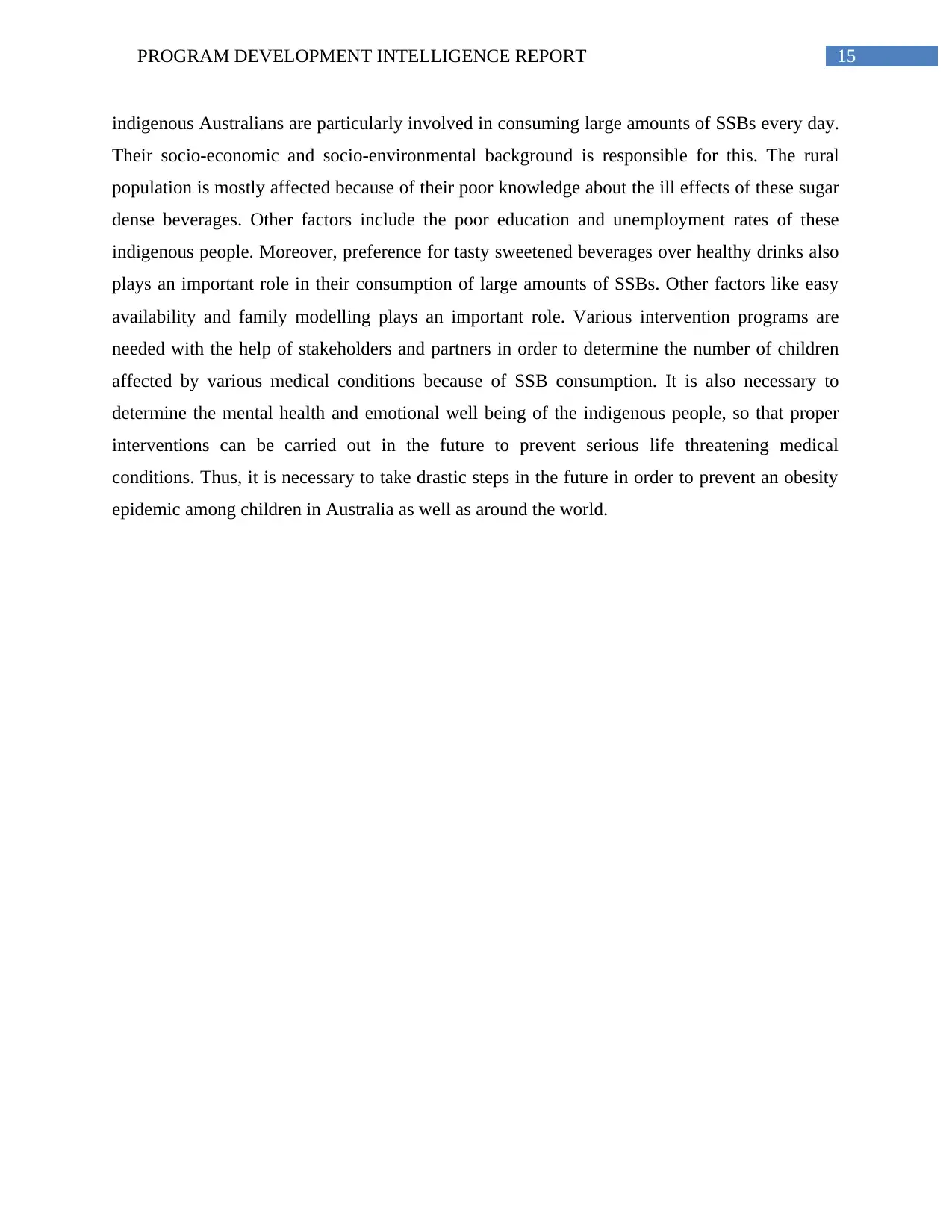
15PROGRAM DEVELOPMENT INTELLIGENCE REPORT
indigenous Australians are particularly involved in consuming large amounts of SSBs every day.
Their socio-economic and socio-environmental background is responsible for this. The rural
population is mostly affected because of their poor knowledge about the ill effects of these sugar
dense beverages. Other factors include the poor education and unemployment rates of these
indigenous people. Moreover, preference for tasty sweetened beverages over healthy drinks also
plays an important role in their consumption of large amounts of SSBs. Other factors like easy
availability and family modelling plays an important role. Various intervention programs are
needed with the help of stakeholders and partners in order to determine the number of children
affected by various medical conditions because of SSB consumption. It is also necessary to
determine the mental health and emotional well being of the indigenous people, so that proper
interventions can be carried out in the future to prevent serious life threatening medical
conditions. Thus, it is necessary to take drastic steps in the future in order to prevent an obesity
epidemic among children in Australia as well as around the world.
indigenous Australians are particularly involved in consuming large amounts of SSBs every day.
Their socio-economic and socio-environmental background is responsible for this. The rural
population is mostly affected because of their poor knowledge about the ill effects of these sugar
dense beverages. Other factors include the poor education and unemployment rates of these
indigenous people. Moreover, preference for tasty sweetened beverages over healthy drinks also
plays an important role in their consumption of large amounts of SSBs. Other factors like easy
availability and family modelling plays an important role. Various intervention programs are
needed with the help of stakeholders and partners in order to determine the number of children
affected by various medical conditions because of SSB consumption. It is also necessary to
determine the mental health and emotional well being of the indigenous people, so that proper
interventions can be carried out in the future to prevent serious life threatening medical
conditions. Thus, it is necessary to take drastic steps in the future in order to prevent an obesity
epidemic among children in Australia as well as around the world.
Secure Best Marks with AI Grader
Need help grading? Try our AI Grader for instant feedback on your assignments.
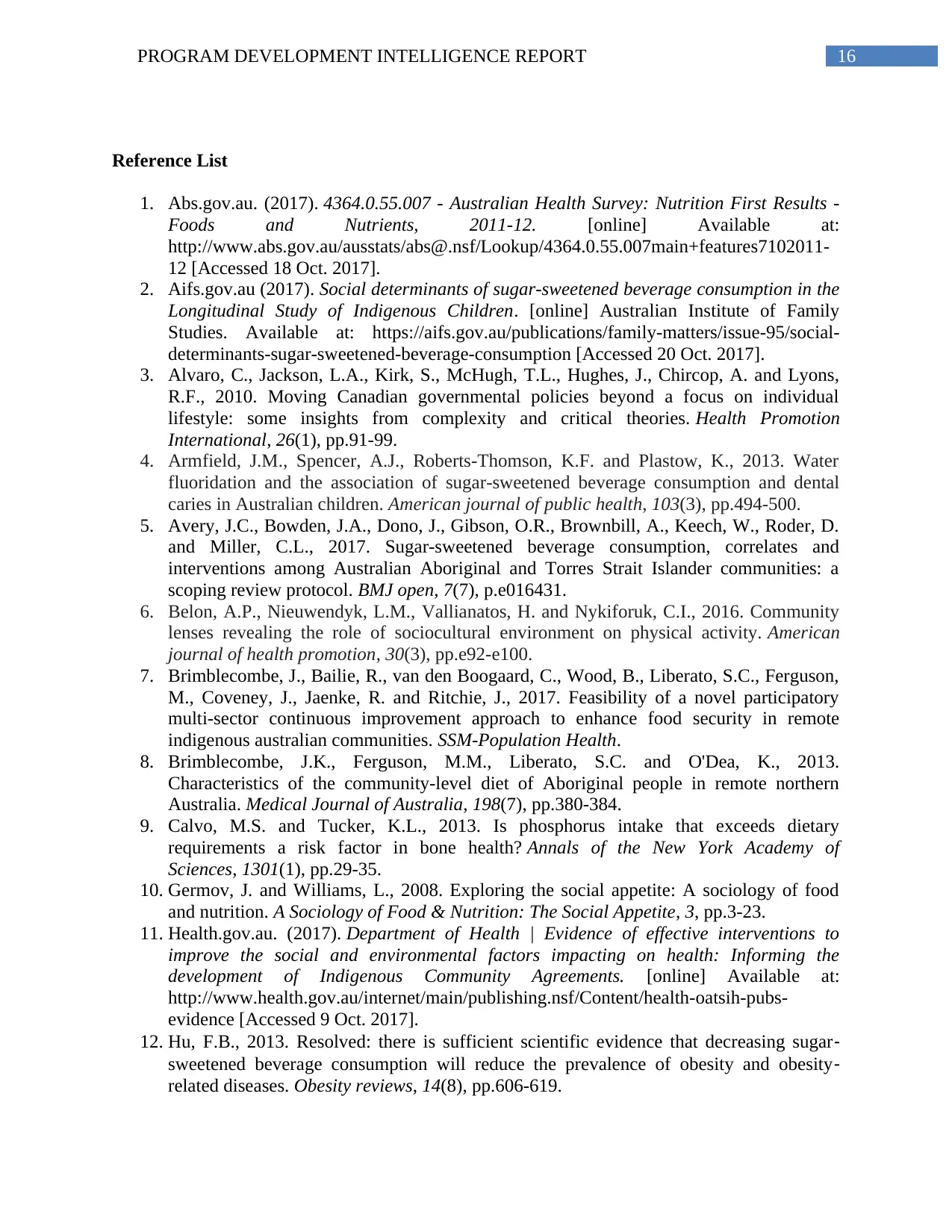
16PROGRAM DEVELOPMENT INTELLIGENCE REPORT
Reference List
1. Abs.gov.au. (2017). 4364.0.55.007 - Australian Health Survey: Nutrition First Results -
Foods and Nutrients, 2011-12. [online] Available at:
http://www.abs.gov.au/ausstats/abs@.nsf/Lookup/4364.0.55.007main+features7102011-
12 [Accessed 18 Oct. 2017].
2. Aifs.gov.au (2017). Social determinants of sugar-sweetened beverage consumption in the
Longitudinal Study of Indigenous Children. [online] Australian Institute of Family
Studies. Available at: https://aifs.gov.au/publications/family-matters/issue-95/social-
determinants-sugar-sweetened-beverage-consumption [Accessed 20 Oct. 2017].
3. Alvaro, C., Jackson, L.A., Kirk, S., McHugh, T.L., Hughes, J., Chircop, A. and Lyons,
R.F., 2010. Moving Canadian governmental policies beyond a focus on individual
lifestyle: some insights from complexity and critical theories. Health Promotion
International, 26(1), pp.91-99.
4. Armfield, J.M., Spencer, A.J., Roberts-Thomson, K.F. and Plastow, K., 2013. Water
fluoridation and the association of sugar-sweetened beverage consumption and dental
caries in Australian children. American journal of public health, 103(3), pp.494-500.
5. Avery, J.C., Bowden, J.A., Dono, J., Gibson, O.R., Brownbill, A., Keech, W., Roder, D.
and Miller, C.L., 2017. Sugar-sweetened beverage consumption, correlates and
interventions among Australian Aboriginal and Torres Strait Islander communities: a
scoping review protocol. BMJ open, 7(7), p.e016431.
6. Belon, A.P., Nieuwendyk, L.M., Vallianatos, H. and Nykiforuk, C.I., 2016. Community
lenses revealing the role of sociocultural environment on physical activity. American
journal of health promotion, 30(3), pp.e92-e100.
7. Brimblecombe, J., Bailie, R., van den Boogaard, C., Wood, B., Liberato, S.C., Ferguson,
M., Coveney, J., Jaenke, R. and Ritchie, J., 2017. Feasibility of a novel participatory
multi-sector continuous improvement approach to enhance food security in remote
indigenous australian communities. SSM-Population Health.
8. Brimblecombe, J.K., Ferguson, M.M., Liberato, S.C. and O'Dea, K., 2013.
Characteristics of the community-level diet of Aboriginal people in remote northern
Australia. Medical Journal of Australia, 198(7), pp.380-384.
9. Calvo, M.S. and Tucker, K.L., 2013. Is phosphorus intake that exceeds dietary
requirements a risk factor in bone health? Annals of the New York Academy of
Sciences, 1301(1), pp.29-35.
10. Germov, J. and Williams, L., 2008. Exploring the social appetite: A sociology of food
and nutrition. A Sociology of Food & Nutrition: The Social Appetite, 3, pp.3-23.
11. Health.gov.au. (2017). Department of Health | Evidence of effective interventions to
improve the social and environmental factors impacting on health: Informing the
development of Indigenous Community Agreements. [online] Available at:
http://www.health.gov.au/internet/main/publishing.nsf/Content/health-oatsih-pubs-
evidence [Accessed 9 Oct. 2017].
12. Hu, F.B., 2013. Resolved: there is sufficient scientific evidence that decreasing sugar‐
sweetened beverage consumption will reduce the prevalence of obesity and obesity‐
related diseases. Obesity reviews, 14(8), pp.606-619.
Reference List
1. Abs.gov.au. (2017). 4364.0.55.007 - Australian Health Survey: Nutrition First Results -
Foods and Nutrients, 2011-12. [online] Available at:
http://www.abs.gov.au/ausstats/abs@.nsf/Lookup/4364.0.55.007main+features7102011-
12 [Accessed 18 Oct. 2017].
2. Aifs.gov.au (2017). Social determinants of sugar-sweetened beverage consumption in the
Longitudinal Study of Indigenous Children. [online] Australian Institute of Family
Studies. Available at: https://aifs.gov.au/publications/family-matters/issue-95/social-
determinants-sugar-sweetened-beverage-consumption [Accessed 20 Oct. 2017].
3. Alvaro, C., Jackson, L.A., Kirk, S., McHugh, T.L., Hughes, J., Chircop, A. and Lyons,
R.F., 2010. Moving Canadian governmental policies beyond a focus on individual
lifestyle: some insights from complexity and critical theories. Health Promotion
International, 26(1), pp.91-99.
4. Armfield, J.M., Spencer, A.J., Roberts-Thomson, K.F. and Plastow, K., 2013. Water
fluoridation and the association of sugar-sweetened beverage consumption and dental
caries in Australian children. American journal of public health, 103(3), pp.494-500.
5. Avery, J.C., Bowden, J.A., Dono, J., Gibson, O.R., Brownbill, A., Keech, W., Roder, D.
and Miller, C.L., 2017. Sugar-sweetened beverage consumption, correlates and
interventions among Australian Aboriginal and Torres Strait Islander communities: a
scoping review protocol. BMJ open, 7(7), p.e016431.
6. Belon, A.P., Nieuwendyk, L.M., Vallianatos, H. and Nykiforuk, C.I., 2016. Community
lenses revealing the role of sociocultural environment on physical activity. American
journal of health promotion, 30(3), pp.e92-e100.
7. Brimblecombe, J., Bailie, R., van den Boogaard, C., Wood, B., Liberato, S.C., Ferguson,
M., Coveney, J., Jaenke, R. and Ritchie, J., 2017. Feasibility of a novel participatory
multi-sector continuous improvement approach to enhance food security in remote
indigenous australian communities. SSM-Population Health.
8. Brimblecombe, J.K., Ferguson, M.M., Liberato, S.C. and O'Dea, K., 2013.
Characteristics of the community-level diet of Aboriginal people in remote northern
Australia. Medical Journal of Australia, 198(7), pp.380-384.
9. Calvo, M.S. and Tucker, K.L., 2013. Is phosphorus intake that exceeds dietary
requirements a risk factor in bone health? Annals of the New York Academy of
Sciences, 1301(1), pp.29-35.
10. Germov, J. and Williams, L., 2008. Exploring the social appetite: A sociology of food
and nutrition. A Sociology of Food & Nutrition: The Social Appetite, 3, pp.3-23.
11. Health.gov.au. (2017). Department of Health | Evidence of effective interventions to
improve the social and environmental factors impacting on health: Informing the
development of Indigenous Community Agreements. [online] Available at:
http://www.health.gov.au/internet/main/publishing.nsf/Content/health-oatsih-pubs-
evidence [Accessed 9 Oct. 2017].
12. Hu, F.B., 2013. Resolved: there is sufficient scientific evidence that decreasing sugar‐
sweetened beverage consumption will reduce the prevalence of obesity and obesity‐
related diseases. Obesity reviews, 14(8), pp.606-619.
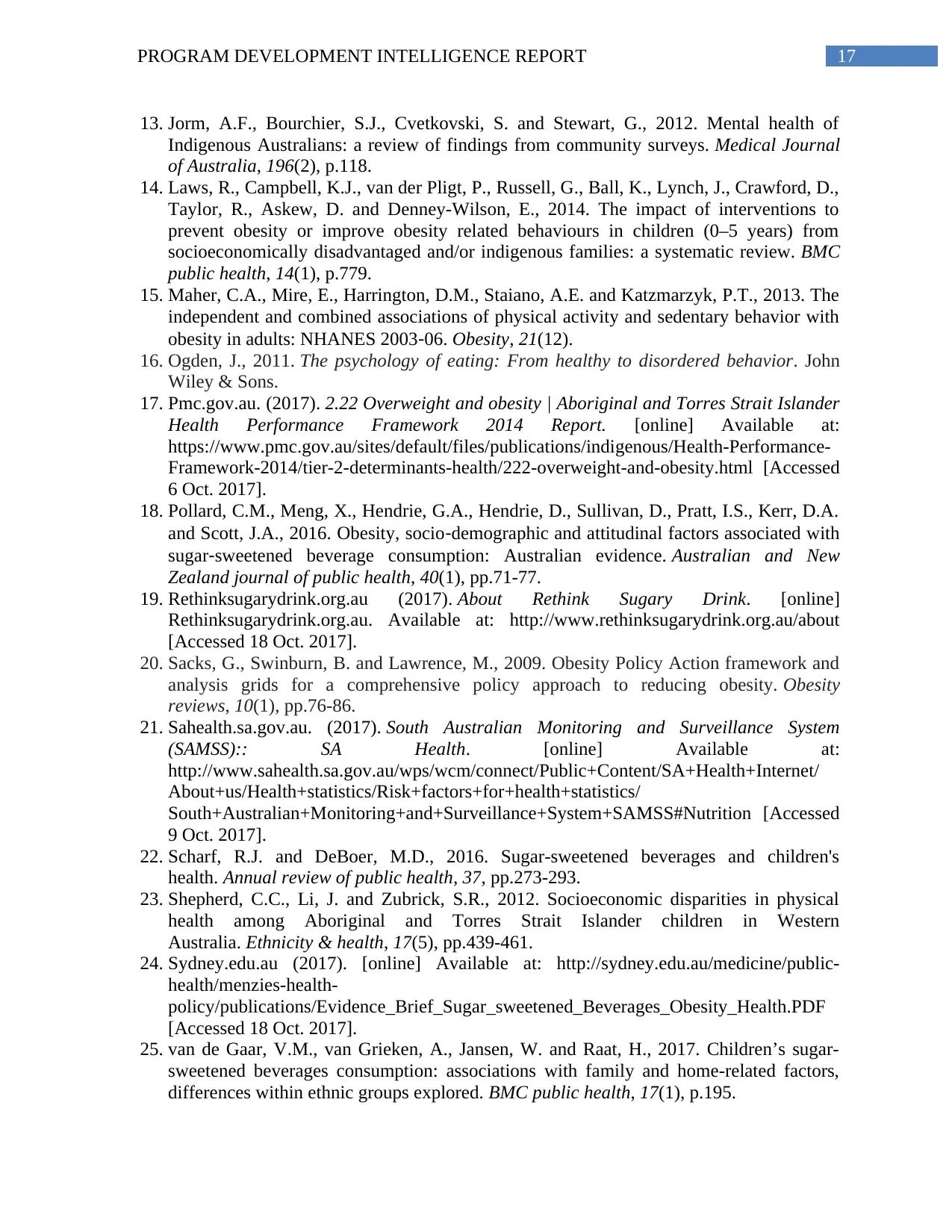
17PROGRAM DEVELOPMENT INTELLIGENCE REPORT
13. Jorm, A.F., Bourchier, S.J., Cvetkovski, S. and Stewart, G., 2012. Mental health of
Indigenous Australians: a review of findings from community surveys. Medical Journal
of Australia, 196(2), p.118.
14. Laws, R., Campbell, K.J., van der Pligt, P., Russell, G., Ball, K., Lynch, J., Crawford, D.,
Taylor, R., Askew, D. and Denney-Wilson, E., 2014. The impact of interventions to
prevent obesity or improve obesity related behaviours in children (0–5 years) from
socioeconomically disadvantaged and/or indigenous families: a systematic review. BMC
public health, 14(1), p.779.
15. Maher, C.A., Mire, E., Harrington, D.M., Staiano, A.E. and Katzmarzyk, P.T., 2013. The
independent and combined associations of physical activity and sedentary behavior with
obesity in adults: NHANES 2003‐06. Obesity, 21(12).
16. Ogden, J., 2011. The psychology of eating: From healthy to disordered behavior. John
Wiley & Sons.
17. Pmc.gov.au. (2017). 2.22 Overweight and obesity | Aboriginal and Torres Strait Islander
Health Performance Framework 2014 Report. [online] Available at:
https://www.pmc.gov.au/sites/default/files/publications/indigenous/Health-Performance-
Framework-2014/tier-2-determinants-health/222-overweight-and-obesity.html [Accessed
6 Oct. 2017].
18. Pollard, C.M., Meng, X., Hendrie, G.A., Hendrie, D., Sullivan, D., Pratt, I.S., Kerr, D.A.
and Scott, J.A., 2016. Obesity, socio‐demographic and attitudinal factors associated with
sugar‐sweetened beverage consumption: Australian evidence. Australian and New
Zealand journal of public health, 40(1), pp.71-77.
19. Rethinksugarydrink.org.au (2017). About Rethink Sugary Drink. [online]
Rethinksugarydrink.org.au. Available at: http://www.rethinksugarydrink.org.au/about
[Accessed 18 Oct. 2017].
20. Sacks, G., Swinburn, B. and Lawrence, M., 2009. Obesity Policy Action framework and
analysis grids for a comprehensive policy approach to reducing obesity. Obesity
reviews, 10(1), pp.76-86.
21. Sahealth.sa.gov.au. (2017). South Australian Monitoring and Surveillance System
(SAMSS):: SA Health. [online] Available at:
http://www.sahealth.sa.gov.au/wps/wcm/connect/Public+Content/SA+Health+Internet/
About+us/Health+statistics/Risk+factors+for+health+statistics/
South+Australian+Monitoring+and+Surveillance+System+SAMSS#Nutrition [Accessed
9 Oct. 2017].
22. Scharf, R.J. and DeBoer, M.D., 2016. Sugar-sweetened beverages and children's
health. Annual review of public health, 37, pp.273-293.
23. Shepherd, C.C., Li, J. and Zubrick, S.R., 2012. Socioeconomic disparities in physical
health among Aboriginal and Torres Strait Islander children in Western
Australia. Ethnicity & health, 17(5), pp.439-461.
24. Sydney.edu.au (2017). [online] Available at: http://sydney.edu.au/medicine/public-
health/menzies-health-
policy/publications/Evidence_Brief_Sugar_sweetened_Beverages_Obesity_Health.PDF
[Accessed 18 Oct. 2017].
25. van de Gaar, V.M., van Grieken, A., Jansen, W. and Raat, H., 2017. Children’s sugar-
sweetened beverages consumption: associations with family and home-related factors,
differences within ethnic groups explored. BMC public health, 17(1), p.195.
13. Jorm, A.F., Bourchier, S.J., Cvetkovski, S. and Stewart, G., 2012. Mental health of
Indigenous Australians: a review of findings from community surveys. Medical Journal
of Australia, 196(2), p.118.
14. Laws, R., Campbell, K.J., van der Pligt, P., Russell, G., Ball, K., Lynch, J., Crawford, D.,
Taylor, R., Askew, D. and Denney-Wilson, E., 2014. The impact of interventions to
prevent obesity or improve obesity related behaviours in children (0–5 years) from
socioeconomically disadvantaged and/or indigenous families: a systematic review. BMC
public health, 14(1), p.779.
15. Maher, C.A., Mire, E., Harrington, D.M., Staiano, A.E. and Katzmarzyk, P.T., 2013. The
independent and combined associations of physical activity and sedentary behavior with
obesity in adults: NHANES 2003‐06. Obesity, 21(12).
16. Ogden, J., 2011. The psychology of eating: From healthy to disordered behavior. John
Wiley & Sons.
17. Pmc.gov.au. (2017). 2.22 Overweight and obesity | Aboriginal and Torres Strait Islander
Health Performance Framework 2014 Report. [online] Available at:
https://www.pmc.gov.au/sites/default/files/publications/indigenous/Health-Performance-
Framework-2014/tier-2-determinants-health/222-overweight-and-obesity.html [Accessed
6 Oct. 2017].
18. Pollard, C.M., Meng, X., Hendrie, G.A., Hendrie, D., Sullivan, D., Pratt, I.S., Kerr, D.A.
and Scott, J.A., 2016. Obesity, socio‐demographic and attitudinal factors associated with
sugar‐sweetened beverage consumption: Australian evidence. Australian and New
Zealand journal of public health, 40(1), pp.71-77.
19. Rethinksugarydrink.org.au (2017). About Rethink Sugary Drink. [online]
Rethinksugarydrink.org.au. Available at: http://www.rethinksugarydrink.org.au/about
[Accessed 18 Oct. 2017].
20. Sacks, G., Swinburn, B. and Lawrence, M., 2009. Obesity Policy Action framework and
analysis grids for a comprehensive policy approach to reducing obesity. Obesity
reviews, 10(1), pp.76-86.
21. Sahealth.sa.gov.au. (2017). South Australian Monitoring and Surveillance System
(SAMSS):: SA Health. [online] Available at:
http://www.sahealth.sa.gov.au/wps/wcm/connect/Public+Content/SA+Health+Internet/
About+us/Health+statistics/Risk+factors+for+health+statistics/
South+Australian+Monitoring+and+Surveillance+System+SAMSS#Nutrition [Accessed
9 Oct. 2017].
22. Scharf, R.J. and DeBoer, M.D., 2016. Sugar-sweetened beverages and children's
health. Annual review of public health, 37, pp.273-293.
23. Shepherd, C.C., Li, J. and Zubrick, S.R., 2012. Socioeconomic disparities in physical
health among Aboriginal and Torres Strait Islander children in Western
Australia. Ethnicity & health, 17(5), pp.439-461.
24. Sydney.edu.au (2017). [online] Available at: http://sydney.edu.au/medicine/public-
health/menzies-health-
policy/publications/Evidence_Brief_Sugar_sweetened_Beverages_Obesity_Health.PDF
[Accessed 18 Oct. 2017].
25. van de Gaar, V.M., van Grieken, A., Jansen, W. and Raat, H., 2017. Children’s sugar-
sweetened beverages consumption: associations with family and home-related factors,
differences within ethnic groups explored. BMC public health, 17(1), p.195.
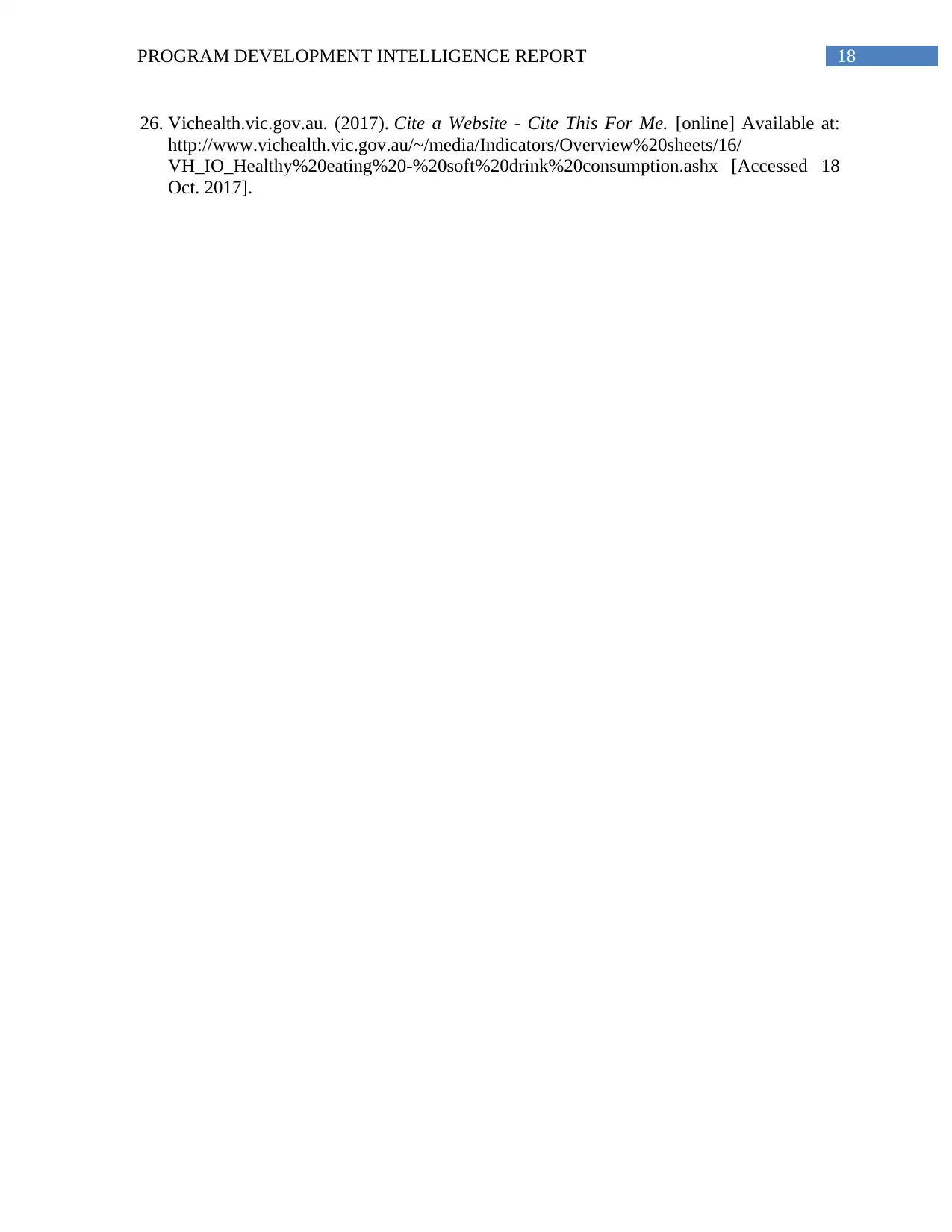
18PROGRAM DEVELOPMENT INTELLIGENCE REPORT
26. Vichealth.vic.gov.au. (2017). Cite a Website - Cite This For Me. [online] Available at:
http://www.vichealth.vic.gov.au/~/media/Indicators/Overview%20sheets/16/
VH_IO_Healthy%20eating%20-%20soft%20drink%20consumption.ashx [Accessed 18
Oct. 2017].
26. Vichealth.vic.gov.au. (2017). Cite a Website - Cite This For Me. [online] Available at:
http://www.vichealth.vic.gov.au/~/media/Indicators/Overview%20sheets/16/
VH_IO_Healthy%20eating%20-%20soft%20drink%20consumption.ashx [Accessed 18
Oct. 2017].
1 out of 19
Related Documents
Your All-in-One AI-Powered Toolkit for Academic Success.
+13062052269
info@desklib.com
Available 24*7 on WhatsApp / Email
![[object Object]](/_next/static/media/star-bottom.7253800d.svg)
Unlock your academic potential
© 2024 | Zucol Services PVT LTD | All rights reserved.





